Cisco Systems 7900001 802.11a/b/g Wireless IP Phone User Manual 7921
Cisco Systems Inc 802.11a/b/g Wireless IP Phone 7921
Manual

FINAL REVIEW - Cisco Confidential
Corporate Headquarters
Cisco Systems, Inc.
170 West Tasman Drive
San Jose, CA 95134-1706
USA
http://www.cisco.com
Tel: 408 526-4000
800 553-NETS (6387)
Fax: 408 526-4100
Cisco Unified Wireless IP Phone
7921G for Cisco Unified CallManager
4.1, 4.2, 5.0 and Later
INCLUDING LICENSE AND WARRANTY
Phone Guide
FINAL REVIEW - Cisco Confidential

Cisco Unified Wireless IP Phone 7921G for Cisco Unified CallManager 4.1, 4.2, 5.0 and Later iii
FINAL REVIEW - Cisco Confidential
Contents
Getting Started 1
Using this Guide 1
Finding Additional Information 2
Cisco Unified Wireless IP Phones and Regulatory Domains 2
Safety and Performance Information 2
Battery Safety Notices 3
Accessibility Features 5
Connecting Your Phone 6
Installing or Removing the Phone Battery 6
Charging the Phone Battery 7
Using the AC Power Supply to Charge the Battery 8
Using the USB Cable and PC Port to Charge the Battery 9
Powering On the Phone 10
Setting Username and Passwords 11
Entering and Editing Text 11
Accessories for the Cisco Unified Wireless IP Phone 7921G 12
An Overview of Your Phone 14
Understanding Buttons and Hardware 14
Understanding Phone Screen Features 17
Understanding Feature Buttons and Menus 19
Understanding the Help System on Your Phone 20
Using Phone Buttons 21
Understanding Lines vs. Calls 21
Understanding Line and Call Icons 22
Understanding Feature Availability 23
Cleaning the Phone 23
iv OL-10806-01
FINAL REVIEW - Cisco Confidential
Basic Call Handling 24
Placing a Call—Basic Options 24
Placing a Call—Additional Options 25
Answering a Call 27
Ending a Call 28
Using Hold and Resume 28
Using Mute 29
Switching Between Multiple Calls 29
Transferring Calls 30
Forwarding All Calls to Another Number 31
Making Conference Calls 32
Understanding Types of Conference Calls 32
Starting and Joining a Standard Conference 32
Starting or Joining a Meet-Me Conference Call 34
Advanced Call Handling 35
Speed Dialing 35
Using Speed Dial and Fast Dial 35
Picking Up Redirected Calls on Your Phone 36
Using a Shared Line 37
Understanding Shared Lines 37
Adding Yourself to a Shared-Line Call 38
Preventing Others from Viewing or Joining a Shared-Line Call 39
Storing and Retrieving Parked Calls 39
Making and Receiving Secure Calls 40
Tracing Suspicious Calls 40
Prioritizing Critical Calls 41
Using Cisco Extension Mobility 42
Logging Out of Hunt Groups 42
Using a Handset, Headset, and Speakerphone 43
Obtaining a Headset 43
Using AutoAnswer 44
Cisco Unified Wireless IP Phone 7921G for Cisco Unified CallManager 4.1, 4.2, 5.0 and Later v
FINAL REVIEW - Cisco Confidential
Using Phone Settings 45
Customizing Rings 45
Customizing Volume Settings 46
Customizing the Phone Screen 47
Changing Keypad Settings 48
Using Any Key to Answer the Phone 48
Setting the Keypad to Automatically Lock 49
Changing the Keypad Tones 50
Viewing Your Network Profile List 50
Using Call Logs and Directories 51
Using Call Logs 51
Directory Dialing 51
Using Corporate Directory on Your Phone 52
Using Personal Directory on Your Phone 52
Cisco Unified CallManager Release 4.0 and Later 52
Cisco Unified CallManager Release 5.0 and Later 53
Accessing Voice Messages 56
Accessing Your User Options Web Pages 57
Cisco Unified CallManager Release 4.1 and Later
User Options Web Pages 57
Logging In to the User Options Web Pages 57
Subscribing to Phone Services 58
Cisco Unified CallManager Release 5.0 and Later
User Options Web Pages 59
Accessing Your User Options Web Pages 59
Configuring Features and Services on the Web 60
Setting Up Speed Dials on the Web 60
Using Personal Directory on the Web 61
Using Your Personal Address Book on the Web 62
Configuring Fast Dials on the Web 63
Using the Address Book Synchronization Tool 64
Setting Up Phone Services on the Web 64
vi OL-10806-01
FINAL REVIEW - Cisco Confidential
Controlling User Settings on the Web 65
Controlling Line Settings on the Web 66
Using Cisco WebDialer 68
Understanding Additional Configuration Options 70
Troubleshooting Your Phone 72
General Troubleshooting 72
Viewing Phone Administration Data 73
Using the Quality Reporting Tool 73
Cisco One-Year Limited Hardware Warranty Terms 74
Index 1
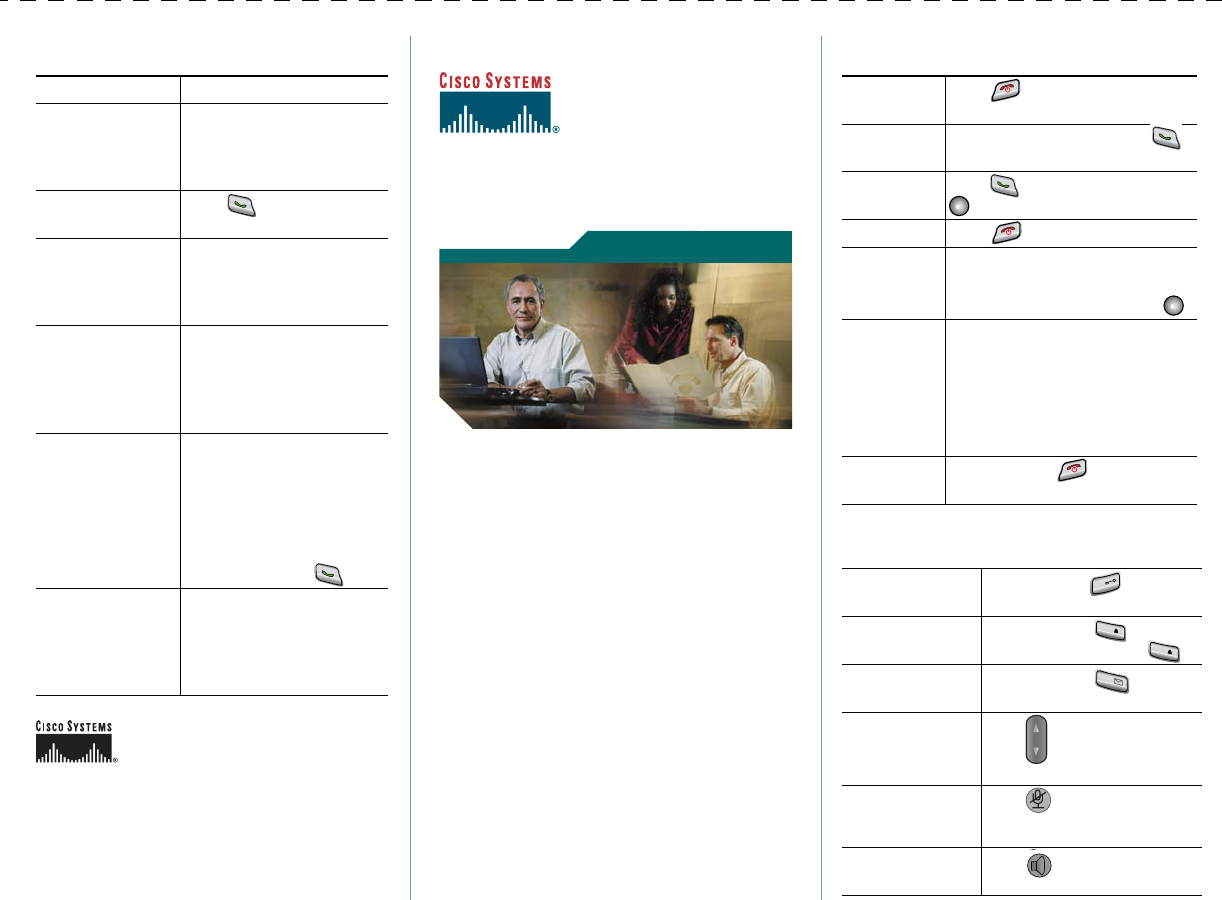
Cisco, Cisco IOS, Cisco Systems, and the Cisco Systems logo are
registered trademarks of Cisco Systems, Inc. or its affiliates in the U.S.
and certain other countries. All other brands, names, or trademarks
mentioned in this document or Web site are the property of their
respective owners. The use of the word partner does not imply a
partnership relationship between Cisco and any other company.
(0501R)
© 2006 Cisco Systems, Inc. All rights reserved.
OL-10806-01
Quick Reference
Cisco Unified Wireless
IP Phone 7921G for
Cisco Unified CallManager
4.1, 4.2, 5.0 and Later
Common Phone Tasks
Using the Phone
Shortcut Keys and Buttons
Softkey Definitions
Phone Screen Icons
Entering Text
Using the Phone
Shortcut Keys and Buttons
Power on the
phone
Press (red key) and hold until
phone powers on.
Place a call Dial the number, then press
(green key). (There is no dial tone).
Answer a call Press (green key), Answer, or
.
Disconnect Press (red key) or EndCall.
Access phone
features
Press Options for feature list:
•Press number key for feature or
•Scroll to feature and press .
Access Main
menu options
Press a navigation arrow for:
•Directory menu (Book)
•Line view (Phone)
•Settings menu (Tools)
•Services menu (World)
Press number key for menu option.
Power off the
phone
Press and hold (red key) until
phone powers off.
Lock/unlock the
keypad
Press and hold (# key). To
unlock, press any key and Yes.
Toggle ringer to
vibrate
Press and hold (* key).
To activate ring, press .
Access voice
messages
Press and hold (1 key).
Adjust ring volume
Adjust handset or
speaker volume
Press up or down.
Press up or down during a
call.
Mute your phone Press .
To unmute microphone, press
button again.
Activate speaker Press . To return to
handset, press button again.
#
*
*
1
@
Common Phone Tasks
Hold/resume a call Press Hold or Resume.
Transfer a call to a
new number
Choose Options >Trnsfer,
enter a target number, then
press Options >Trnsfer
again.
Redial a number Press twice or
Options > Redial.
Start a standard
conference call
Choose Options > Confrn.
Dial a number, then press
Options > Confrn again.
Repeat for each party.
Forward your
extension
Choose Options > CFwdAll.
Enter the number to which
you want to forward all
calls. Cancel using
Options > CFwdAll.
Use your call logs Choose Directory (Book).
Then select one of these:
•Missed Calls
•Received Calls
•Placed Calls
To dial, scroll to a listing
and press Dial or .
Move a shared line
call between desk
phone and wireless
phone
From the phone with the
active call, press Hold. From
the other phone, highlight
the shared-line call, then use
Resume to retrieve the call.
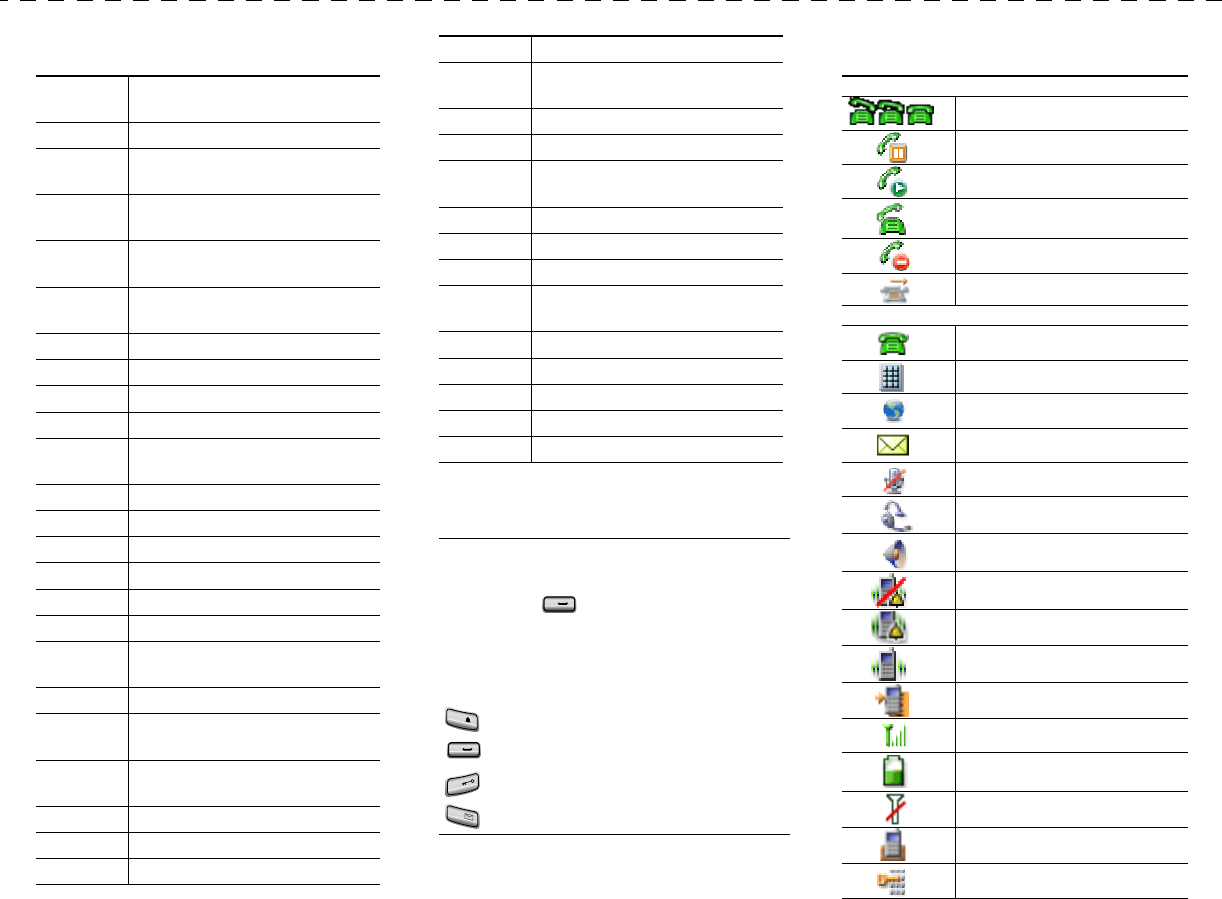
Softkey Definitions
AbbrDial Dial using a speed dial index
number
Answer Answer a call
Barge Add yourself to a call on a shared
line
CallBack Receive notification when a busy
extension becomes available
Cancel Cancel an action or exit a screen
without applying changes
cBarge Add yourself to a call on a shared
line and establish a conference
CFwdAll Setup/cancel call forwarding
Clear Delete records or settings
ConfList View conference participants
Confrn Create a conference call
Delete Remove characters or item at the
cursor
Detail Display details in a record
Dial Dial a phone number
DirTrfr Transfer two calls to each other
Edit Change a setting
EditDial Edit a number in a call log
EndCall Disconnect current call
GPickUp Answer a call ringing in another
group
HLog Log in or out of your hunt group
iDivert Send a call to your voice messaging
system
Join Join several calls already on a
single line to create a conference
MCID Report suspicious calls
MeetMe Host a Meet-Me conference call
NewCall Make a new call
Entering Text
Options Access softkey feature list
OPickUp Answer a call ringing in another
group associated with your group
Park Store a call using Call Park
PickUp Answer a call in your group
QRT Submit call problems to the system
administrator
Redial Redial the most recent number
Remove Remove a conference participant
Resume Resume a call on hold
RmLstC Drop the last party added to a
conference call
Save Save the chosen settings
Select Choose an option or call
Submit Search for a directory listing
Trnsfer Transfer a call
Update Refresh content
Character—Press appropriate key to highlight
and enter the lower or upper case character.
Space—Press to enter a space.
Number—Press the number key to highlight and
enter the number.
Symbol—Press these keys to display symbols.
to enter * + - / = \ : ;
to enter space , . ‘ “ | _ ~ ’
to enter # ? ( ) [ ] { }
to enter ! @ < > $ % ^ &
0
*
0
#
1
@
Phone Screen Icons
Line and Call States
Incoming call
Call on hold
Connected call
Off-hook
Shared line in use
Call Forwarding enabled
Other Features
Phone line
Speed-dial number
Service URL
Voice message
Mute on
Headset in use
Speaker mode active
Ringer off (silent mode)
Ring and vibrate on
Vibrate only on
Push to talk in use
Radio signal
Battery charge status
No radio signal
Docked in desk top charger
Keypad lockec

Cisco Unified Wireless IP Phone 7921G for Cisco Unified CallManager 4.1, 4.2, 5.0 and Later 1
FINAL REVIEW - Cisco Confidential
Getting Started
Using this Guide
This guide provides you with an overview of the features available on your phone. You can read it
completely for a solid understanding of your phone’s capabilities, or refer to the table below for
pointers to commonly-used sections.
If you want to... Then...
Review important safety information See Safety and Performance Information, page 2.
Connect your phone to the network See Connecting Your Phone, page 6.
Use your phone after it is installed Start with the An Overview of Your Phone, page 14.
Learn about the buttons and menus See Understanding Feature Buttons and Menus, page 19.
Learn about the phone screen See Understanding Phone Screen Features, page 17.
Make calls See Placing a Call—Basic Options, page 24.
Put calls on hold See Using Hold and Resume, page 28.
Mute calls See Using Mute, page 29.
Transfer calls See Transferring Calls, page 30.
Make conference calls See Making Conference Calls, page 32.
Forward calls to another number See Forwarding All Calls to Another Number, page 31.
Share a phone number See Using a Shared Line, page 37.
Answer calls ringing on another phone See Picking Up Redirected Calls on Your Phone, page 36.
Use your phone as a speakerphone See Using a Handset, Headset, and Speakerphone, page 43.
Set up speed dialing See Speed Dialing, page 35.
Change the ring volume or tone See Customizing Rings, page 45.
View your missed calls See Using Call Logs and Directories, page 51.
Listen to voice messages See Accessing Voice Messages, page 56.
Customizing your phone using the
User Options web pages
See Accessing Your User Options Web Pages, page 57.
See softkey and icon definitions Refer to the Quick Reference Card in the front of this guide.

2OL-10806-01
FINAL REVIEW - Cisco Confidential
Finding Additional Information
You can access the most current Cisco documentation on the World Wide Web at this URL:
http://www.cisco.com/techsupport
You can access the Cisco website at this URL:
http://www.cisco.com/
International Cisco websites can be accessed from this URL:
http://www.cisco.com/public/countries_languages.shtml
Cisco Unified Wireless IP Phones and Regulatory Domains
The radio frequency (RF) for this phone is configured for a specific regulatory domain. If you use this
phone outside of its regulatory domain, the phone will not function properly, and you might violate
local regulations.
Safety and Performance Information
Read the following safety notices before installing or using your wireless IP phone.
Note To see translations of the warnings that appear in this publication, refer to the statement
number in the Regulatory Compliance and Safety Information for the Cisco Unified Wireless
IP Phone 7921G document that accompanied this product.
Warning
IMPORTANT SAFETY INSTRUCTIONS
This warning symbol means danger. You are in a situation that could cause
bodily injury. Before you work on any equipment, be aware of the hazards
involved with electrical circuitry and be familiar with standard practices for
preventing accidents. Use the statement number provided at the end of each
warning to locate its translation in the translated safety warnings that
accompanied this device.
Statement 1071
SAVE THESE INSTRUCTIONS

Getting Started
Cisco Unified Wireless IP Phone 7921G for Cisco Unified CallManager 4.1, 4.2, 5.0 and Later 3
FINAL REVIEW - Cisco Confidential
Warning
Read the installation instructions before connecting the system to the power source.
Statement 1004
Warning
The plug-socket combination on the battery charger must be accessible at all times
because it serves as the main disconnecting device.
Statement 1019
Warning
Voice over IP (VoIP) service and the emergency calling service do not function if power
fails or is disrupted. After power is restored, you might have to reset or reconfigure
equipment to regain access to VoIP and the emergency calling service. In the USA, this
emergency number is 911. You need to be aware of the emergency number in your
country.
Statement 361
Warning
Do not use the Cisco Unified Wireless IP Phone 7921G in hazardous environments such
as areas where high levels of explosive gas may be present. Check with the site safety
engineer before using any type of wireless device in such an area.
Warning
The battery charger requires short-circuit (overcurrent) protection to be provided as part
of the building installation. Install only in accordance with national and local wiring
regulations.
Statement 1045
Battery Safety Notices
These battery safety notices apply to the batteries that are approved by the Cisco Unified Wireless IP
Phone 7921G manufacturer.
Warning
There is the danger of explosion if the battery is replaced incorrectly. Replace the battery
only with the same or equivalent type recommended by the manufacturer. Dispose of
used batteries according to the manufacturer’s instructions.
Statement 1015
Warning
Ultimate disposal of this product should be handled according to all national laws and
regulations.
Statement 1040

4OL-10806-01
FINAL REVIEW - Cisco Confidential
Warning
Do not dispose of the battery pack in fire or water. The battery may explode if placed in
a fire.
Caution The battery pack is intended for use only with this device.
Caution Do not disassemble, crush, puncture, or incinerate the battery pack.
Caution To avoid risk of fire, burns, or damage to your battery pack, do not allow a metal object
to touch the battery contacts.
Caution Handle a damaged or leaking battery with extreme care. If you come in contact with the
electrolyte, wash the exposed area with soap and water. If the electrolyte has come in
contact with the eye, flush the eye with water for 15 minutes and seek medical attention.
Caution Do not charge the battery pack if the ambient temperature exceeds 104 degrees
Fahrenheit (40 degrees Celsius).
Caution Do not expose the battery pack to high storage temperatures (above 140 degrees
Fahrenheit, 60 degrees Celsius).
Caution When discarding a battery pack, contact your local waste disposal provider regarding
local restrictions on the disposal or recycling of batteries.
Caution To obtain a replacement battery, contact your local dealer. Use only the batteries that have
a Cisco part number.
Standard battery—CP-BATT-7921G-STD
Extended use battery—CP-BATT-7921G-EXT

Getting Started
Cisco Unified Wireless IP Phone 7921G for Cisco Unified CallManager 4.1, 4.2, 5.0 and Later 5
FINAL REVIEW - Cisco Confidential
Caution Use only the Cisco power supply that was provided with your phone. If you need to replace
your power supply, refer to the list of Cisco part numbers.
Australia—CP-PWR-7921G-AU
Central Europe—CP-PWR-7921G-CE
China—CP-PWR-7921G-CN
Japan—CP-PWR-7921G-JP
North America—CP-PWR-7921G-NA
United Kingdom—CP-PWR-7921G-UK
Power Outage
Your accessibility to emergency service through the phone is dependent on the wireless access point
being powered. If there is an interruption in the power supply, Service and Emergency Calling Service
dialing will not function until power is restored. In the case of a power failure or disruption, you may
need to reset or reconfigure equipment before using the Service or Emergency Calling Service dialing.
Using External Devices
The following information applies when you use external devices with the Cisco Unified Wireless IP
Phone:
Cisco recommends the use of good quality external devices (such as headsets) that are shielded against
unwanted radio frequency (RF) and audio frequency (AF) signals.
Depending on the quality of these devices and their proximity to other devices such as mobile phones
or two-way radios, some audio noise may still occur. In these cases, Cisco recommends that you take
one or more of the following actions:
•Move the external device away from the source of the RF or AF signals.
•Route the external device cables away from the source of the RF or AF signals.
•Use shielded cables for the external device, or use cables with a better shield and connector.
•Shorten the length of the external device cable.
•Apply ferrites or other such devices on the cables for the external device.
Cisco cannot guarantee the performance of the system because Cisco has no control over the quality
of external devices, cables, and connectors. The system will perform adequately when suitable devices
are attached using good quality cables and connectors.
Caution In European Union countries, use only external headsets that are fully compliant with the
EMC Directive [89/336/EC].
Accessibility Features
A list of accessibility features is available upon request.

6OL-10806-01
FINAL REVIEW - Cisco Confidential
Connecting Your Phone
Your phone administrator will configure your new Cisco Unified Wireless IP Phone to connect to the
corporate wireless network and the IP telephony network.
A rechargeable Lithium ion battery powers the Cisco Unified Wireless IP Phone 7921G. Before you
can use your phone, you must install the battery in the phone and then charge the battery. Depending
on the type of battery you have, the fully charged battery provides these hours of service:
•The standard battery provides up to 8 hours of talk time or up to 70 hours of standby time.
•The extended battery provides up to 9.5 hours of talk time or up to 85 hours of standby time.
Installing or Removing the Phone Battery
To install or remove the battery, follow these steps:
If you want to... Then...
Install the battery 1. Insert the battery catches in the slots at the bottom of the phone. The
metal contacts on the battery and the phone must face each other.
2. Press the battery to the phone until it locks into place.
Remove the battery 1. Press up on the locking catch with one hand.
2. With the other hand, hold the battery at the edges and pull out to remove
the battery.
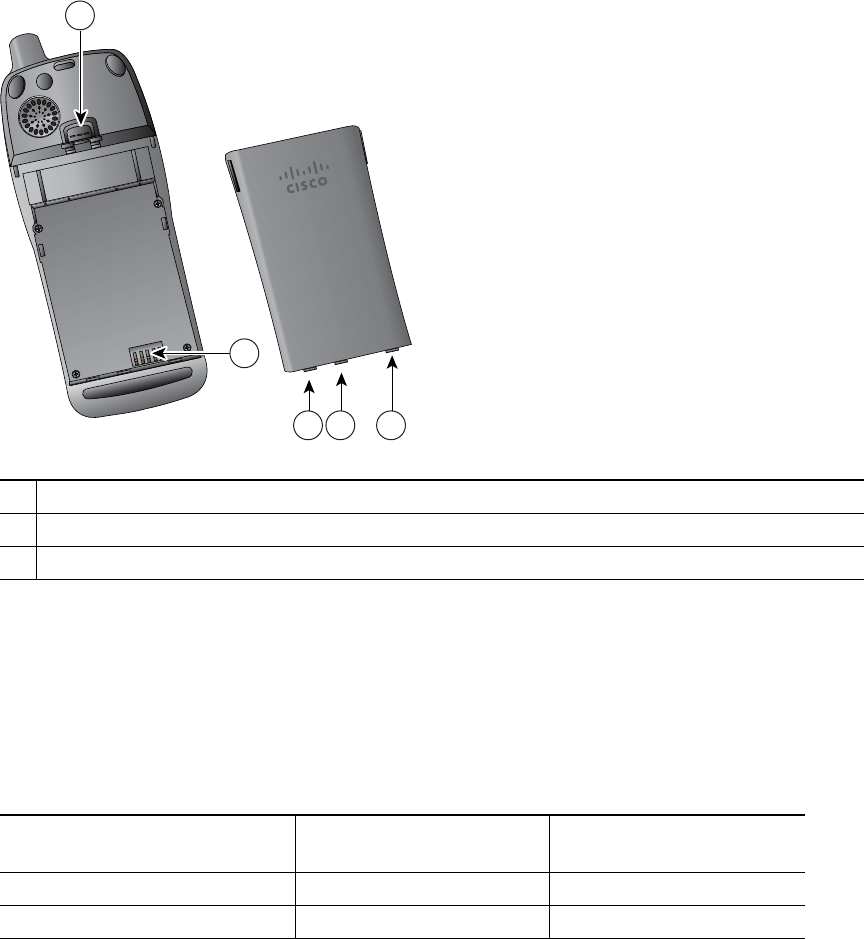
Connecting Your Phone
Cisco Unified Wireless IP Phone 7921G for Cisco Unified CallManager 4.1, 4.2, 5.0 and Later 7
FINAL REVIEW - Cisco Confidential
Charging the Phone Battery
You can charge the battery in your wireless IP phone by connecting the AC power supply or the USB
cable to your phone. For more information, see these sections:
•Using the AC Power Supply to Charge the Battery, page 8
•Using the USB Cable and PC Port to Charge the Battery, page 9
1Locking catch—Push up to release the battery.
2Battery catches—Insert these into the slots near the bottom of the phone at battery installation.
3Metal contacts—Match the contacts on the battery to the contacts on the phone.
Charging Times
Battery Type
AC Power Supply
Connected to Phone
Phone Connected to
PC with USB Cable
Standard 2 hours 5 hours
Extended 3 hours 7 hours
222
1
3
180349
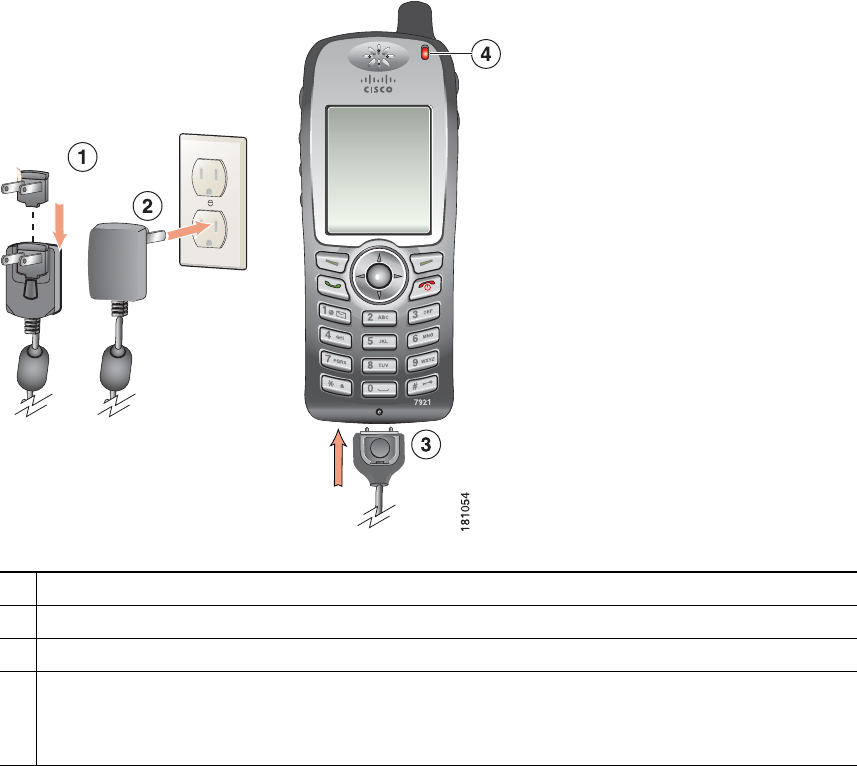
8OL-10806-01
FINAL REVIEW - Cisco Confidential
Using the AC Power Supply to Charge the Battery
You can charge your battery quickly by connecting the AC power supply to the phone. To
accommodate different AC power receptacles, you must insert the appropriate AC plug adapter on the
AC power supply.
You can use the phone while the battery is being charged. After the battery is charged, you can unplug
the power supply cord, or you can leave the phone plugged into the power cord.
To charge the battery in the phone using the AC power supply, use this diagram:
1AC plug adapter—Insert the AC plug adapter into the slot on the power supply.
2AC Power supply—Insert into an AC outlet.
3Phone connector on AC power supply cable—Insert into the connector slot at bottom of phone.
4Indicator light—Indicates the charging status:
•Red—Battery charging in process
•Green—Battery charging is completed
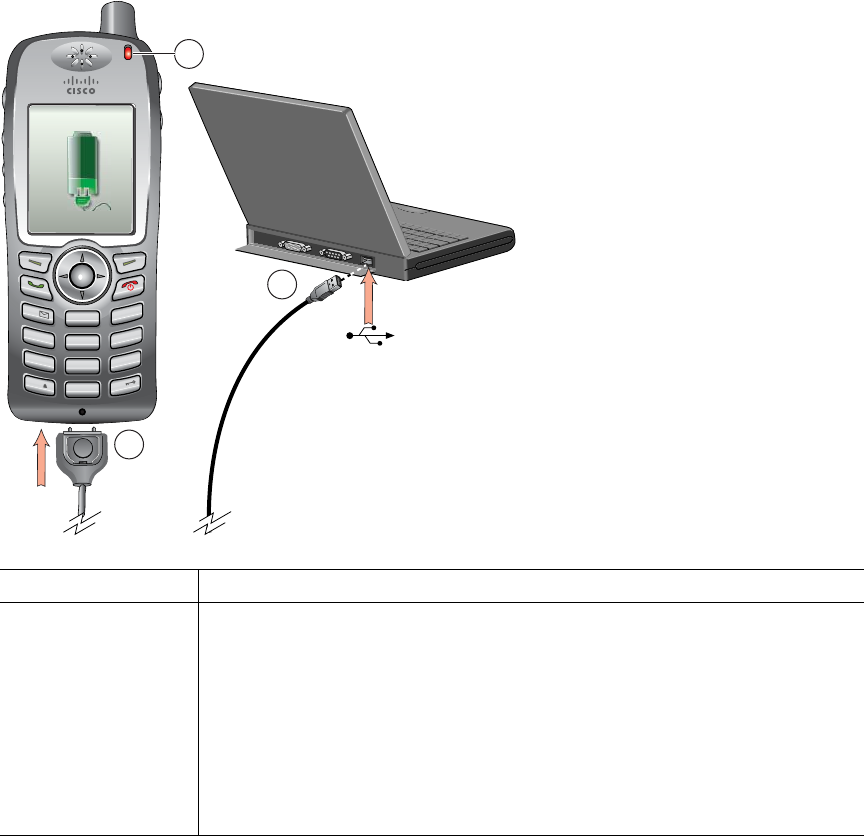
Connecting Your Phone
Cisco Unified Wireless IP Phone 7921G for Cisco Unified CallManager 4.1, 4.2, 5.0 and Later 9
FINAL REVIEW - Cisco Confidential
Using the USB Cable and PC Port to Charge the Battery
You can charge the battery in the phone by connecting your phone with a USB cable to a USB port on
you PC. Charging times are longer when you use the USB port on the PC to charge the battery.
To use the USB cable and USB port to charge the battery, use this diagram and follow the steps:
If you want to... Then...
Charge the battery
using the USB cable
1. Insert the phone connector on the USB cable into the phone.
2. Insert the USB A-type connector into the USB port on your PC.
Note If the Found New Hardware Wizard opens, use the following procedure
to stop it.
3. Monitor the indicator light after the phone briefly displays “USB
Connected” on the status line.
While the battery is charging, the indicator light is red. When the battery
is fully charged, the indicator light turns green.
180350
7921
WXYZ
0
1
@
2ABC
3
DEF
4
5JKL
6
MNO
GHI
7
8TUV
9
PQRS
#
*
1
2
3

10 OL-10806-01
FINAL REVIEW - Cisco Confidential
Powering On the Phone
After charging the battery, you must power on the phone to make and receive calls.
Tip
The indicator light on the phone blinks every 2 seconds to inform you that the phone is active and in
coverage range.
Stop Found New
Hardware Wizard
from opening when
connecting to USB
port
1. Click Next to use the wizard dialog box.
2. In the Update New Software dialog, click No, not this time, and click
Next.
3. Click Install the Software automatically (Recommended) and click Next.
4. After a few moments, the Cannot Install This Hardware dialog appears.
Click Don't prompt me again to install this software.
5. Click Finish to close the dialog box.
If you want to... Then...
Power on the phone 1. Press and hold the (red button) until the phone powers on.
2. You might need to enter a username and password to access the wireless
network. For more information, see Setting Username and Passwords,
page 11.
3. After completing authentication and registration with Cisco Unified
CallManager, the phone displays the main screen and is ready to place or
receive calls.
Check signal strength The signal icon indicates the strength of the signal between the wireless
access point and your phone. Your phone must have at least one bar to place
or receive calls.
When you move the phone out of signal range, you lose connection with the
wireless LAN. The icon appears and the status line displays, “Leaving
service area.”
If you want to... Then...
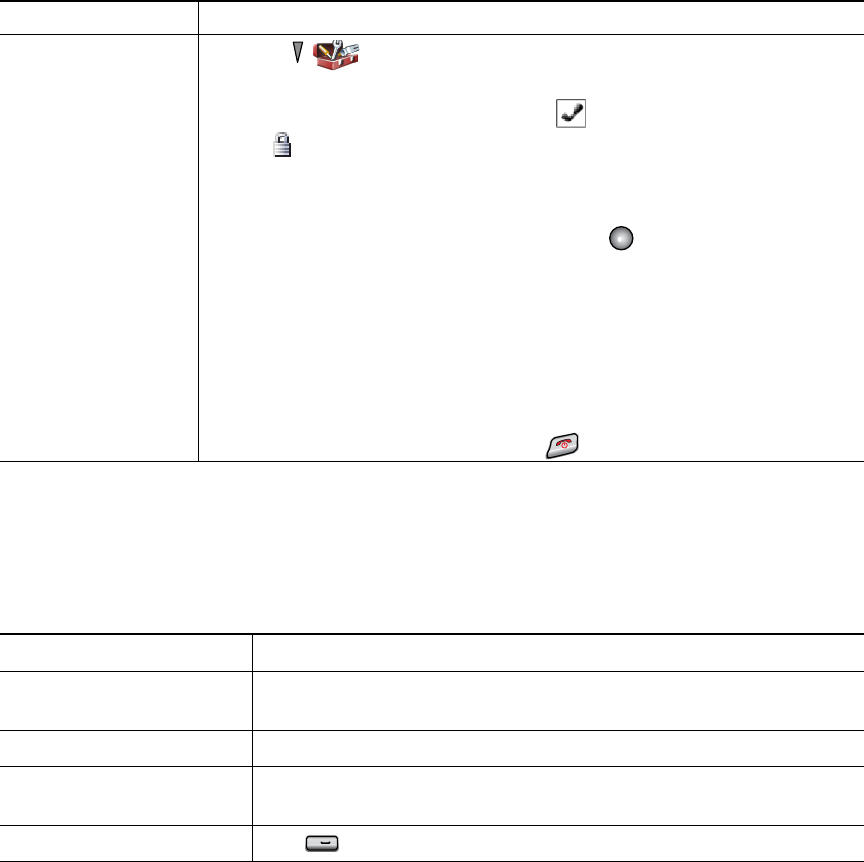
Connecting Your Phone
Cisco Unified Wireless IP Phone 7921G for Cisco Unified CallManager 4.1, 4.2, 5.0 and Later 11
FINAL REVIEW - Cisco Confidential
Setting Username and Passwords
When powering on your phone for the first time, in some networks, you might need to set your
username and password to access the wireless network. Ask your phone administrator for assistance.
Entering and Editing Text
You can enter characters, numbers, and special characters for passwords. When you press a numeric
key on the keypad, a text bubble shows all the characters and symbols that this key controls. Each
press moves to another character option.
If you want to... Then...
Set username and
password
1. Press (Settings).
2. Select Network Profile.
3. Select the current profile name (with ).
Note icon displays indicating that this screen is locked. For assistance,
contact your phone administrator.
4. Press Change, then select WLAN Configuration.
5. Scroll to Username or Password and press .
6. Using the keypad, enter your username or password in the New
Username or New Password field.
For assistance, see Entering and Editing Text, page 11.
Note You can use up to 32 alphanumeric characters for the EAP/LEAP
password.
7. To confirm the changes, choose Options > Save.
8. To return to the main screen, press (red button).
If you want to... Then...
Enter characters Press the number key until you highlight the character (lower or upper
case) that you want to enter.
Enter numbers Press the number key and locate the number that you want to enter.
Delete the last character Press << once to delete the last character or number or to delete the
whole character string, press and hold <<.
Enter a space Press to enter a space between characters.
0

12 OL-10806-01
FINAL REVIEW - Cisco Confidential
Registering with TAPS
After your phone is connected to the wireless LAN network, your phone administrator might ask you
to auto-register your phone using TAPS (Tool for Auto-Registered Phones Support). TAPS might be
used for a new phone or to replace an existing phone.
To register with TAPS, enter the TAPS extension provided by your phone administrator, and follow
the voice prompts. You might need to enter your entire extension, including the area code. After your
phone displays a confirmation message, disconnect. The phone will re-start.
Accessories for the Cisco Unified Wireless IP Phone 7921G
The following phone accessories are available for your phone:
•Standard and extended batteries
•AC power supplies for different geographical areas
•Desktop charger with speakerphone
•Carrying cases
•Lock sets
For a complete list of accessories, refer to the Cisco Unified Wireless IP Phone 7921G Accessory
Guide.
Headset Information
To use a headset, see Using a Handset, Headset, and Speakerphone, page 43. Although Cisco Systems
performs some internal testing of third-party headsets for use with the Cisco Unified IP Phones, Cisco
does not certify or support products from headset or handset vendors. Because of the inherent
environmental and hardware inconsistencies in the locations where Cisco Unified IP Phones are
deployed, there is not a single “best” solution that is optimal for all environments. Cisco recommends
that customers test the headsets that work best in their environment before deploying a large number
of units in their network.
In some instances, the mechanics or electronics of various headsets can cause remote parties to hear
an echo of their own voice when they speak to Cisco Unified IP Phone users.
Enter special characters and
symbols
Press to display and enter these symbols * + - / = \ : ;
Press to display and enter these symbols space , . ‘ “ | _ ~ ’
Press to display and enter these symbols # ? ( ) [ ] { }
Press to display and enter these symbols ! @ < > $ % ^ &
Cancel editing mode Choose Options > Cancel to return to the menu option or main screen.
If you want to... Then...
*
0
#
1
@
Connecting Your Phone
Cisco Unified Wireless IP Phone 7921G for Cisco Unified CallManager 4.1, 4.2, 5.0 and Later 13
FINAL REVIEW - Cisco Confidential
Cisco Systems recommends the use of good quality external devices, like headsets that are screened
against unwanted radio frequency (RF) and audio frequency (AF) signals. Depending on the quality of
these devices and their proximity to other devices such as cell phones and two-way radios, some audio
noise may still occur. See Using External Devices, page 5 for more information.
The primary reason that a particular headset would be inappropriate for the Cisco Unified IP Phone
is the potential for an audible hum. This hum can be heard by either the remote party or by both the
remote party and you, the Cisco Unified IP Phone user. Some potential humming or buzzing sounds
can be caused by a range of outside sources, for example, electric lights, being near electric motors,
large PC monitors.
Audio Quality Subjective to the User
Beyond the physical, mechanical and technical performance, the audio portion of a headset must
sound good to you (the user) and to the party on the far end. Sound is subjective and Cisco cannot
guarantee the performance of any headsets, but some of the headsets on the sites listed below have
been reported to perform well on Cisco Unified IP Phones.
Nevertheless, it is ultimately still the customer's responsibility to test this equipment in their own
environment to determine suitable performance.
For information about headsets for your phone, refer to the Cisco Unified Wireless IP Phone 7921G
Accessory Guide and:
•http://www.plantronics.com
•http://www.jabra.com

14 OL-10806-01
FINAL REVIEW - Cisco Confidential
An Overview of Your Phone
Your Cisco Unified Wireless IP Phone 7921G is a full-feature telephone that provides voice
communication over the same wireless LAN that your computer uses, allowing you to place and
receive phone calls, put calls on hold, transfer calls, make conference calls, and so on.
In addition to basic call-handling features, your phone can provide enhanced productivity features that
extend your call-handling capabilities.
Depending on the configuration, your phone supports:
•Wireless access to your phone number and the corporate directory.
•Access to network data, XML applications, and web-based services.
•Online customizing of phone features and services from your User Options web pages.
•An online help system that displays information on the phone screen.
Understanding Buttons and Hardware
You can use the figure below to identify buttons and hardware on your phone.
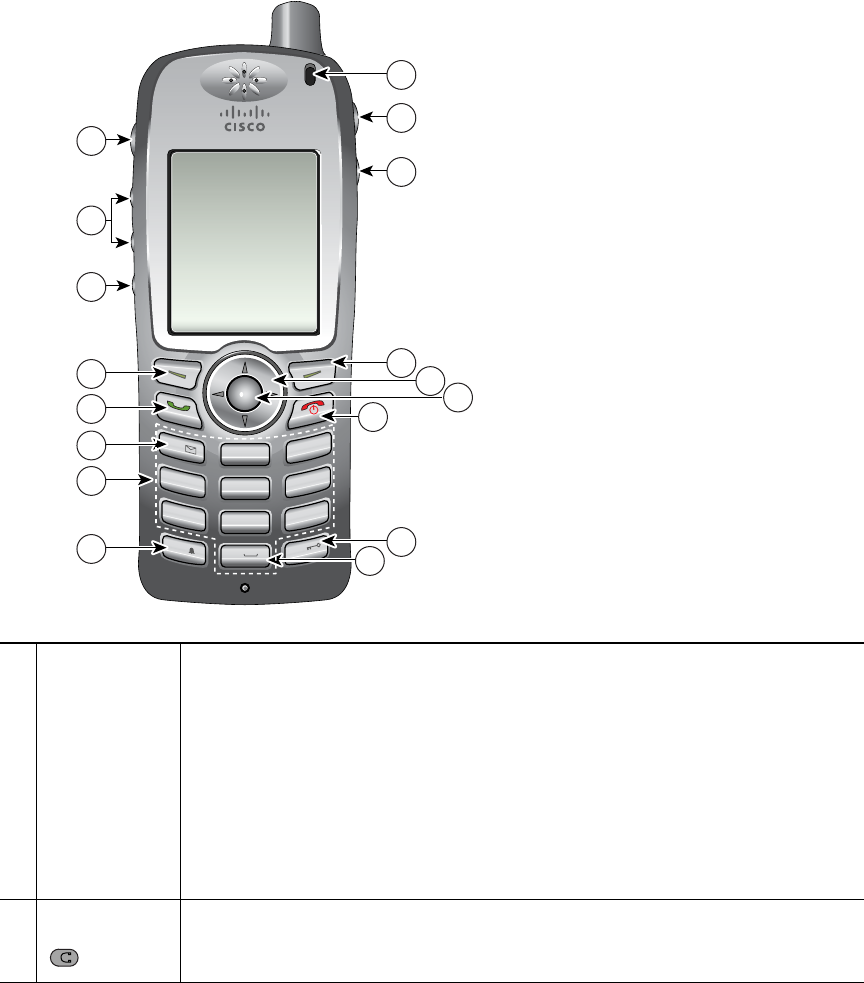
An Overview of Your Phone
Cisco Unified Wireless IP Phone 7921G for Cisco Unified CallManager 4.1, 4.2, 5.0 and Later 15
FINAL REVIEW - Cisco Confidential
1Indicator light
(LED)
Provides these indications:
•Solid red—Phone is connected to power source and battery is charging.
•Solid green—Phone is connected to power source and battery is fully
charged.
•Slow blinking red—Voice message. (Phone can be charging or fully
charged.)
•Fast blinking red—Incoming call. (Phone can be charging or fully charged.)
•Slow blinking green—Phone is disconnected from power source and within
service coverage area.
2Headset port Port for plugging in a headset or ear bud.
180258
WXYZ
0
1
@
2ABC
3
DEF
4
5JKL
6
MNO
GHI
7
8TUV
9
PQRS
#
*
10
13
12
14
15
16
11
17
1
4
8
9
7
6
5
2
3
7921
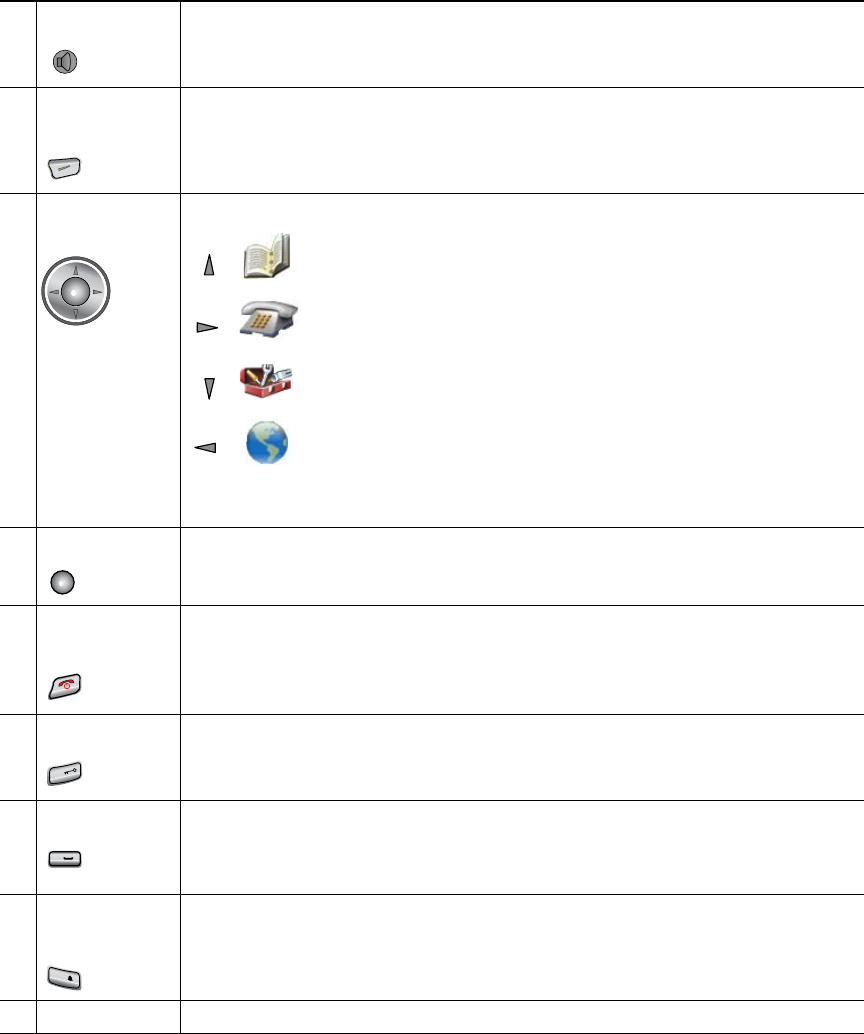
16 OL-10806-01
FINAL REVIEW - Cisco Confidential
3Speaker button Toggles the speaker mode on or off for the phone.
4Right softkey
button
Activates the Options menu for access to the list of softkeys. Sometimes
displays a softkey label.
5Navigation
button
Accesses these menus and lists from the main screen.
(Directory)
(Line View)
(Settings)
(Services)
Allows you to scroll up and down menus to highlight options and to move left
and right through phone numbers and text entries.
6Select button Activates the Help menu from the main screen.
Allows you to select a menu item, a softkey, a call, or an action.
7Power/End
button (red)
Turns the phone on or off, diverts a ringing call to your voice messaging system,
or ends a connected call. If there is no voice messaging system, then silences the
ring.
When using menus, acts as a shortcut to return to the main screen.
8Pound (#) key Toggles between locking and unlocking the key pad.
Allows you to enter these special characters when you are entering text:
# ? ( ) [ ] { }
9Zero (0) key Enters “0” when dialing a number. Allows you to enter a space or these special
characters when you are entering text:
, . ‘ “ | _ ~ ’
10 Asterisk (*)
key
Toggles between Ring and Vibrate mode.
Allows you to enter these special characters when you are entering text:
* + - / = \ : ;
11 Keypad Allows you to dial numbers, enter letters, and choose menu items by number.
#
0
*

An Overview of Your Phone
Cisco Unified Wireless IP Phone 7921G for Cisco Unified CallManager 4.1, 4.2, 5.0 and Later 17
FINAL REVIEW - Cisco Confidential
Understanding Phone Screen Features
Because the Cisco Unified Wireless IP Phone 7921G has only two softkeys, the Options softkey
displays the list of available feature options for the phone. The features in the Options list change
depending on whether the phone is idle or in an active call. This is what your main phone screen looks
like with the Options list open.
12 One (1) key Enters “1” when dialing a number. Allows you to access the voice messaging
system.
Allows you to enter these special characters when you are entering text:
! @ < > $ % ^ &
13 Answer/Send
button (green)
Allows you to answer a ringing call or, after dialing a number, to place the call.
14 Left softkey
button
Activates the softkey option displayed on the screen.
15 Mute button Toggles the mute feature on or off.
16 Volume button When the phone is idle, controls the ring volume, vibrate option or turns off the
ring.
During a call, controls the speaker volume for the handset, headset, and speaker
mode.
17 Push to Talk
button
Available with some XML applications; when being used, an icon displays on
the phone status line.
1
@
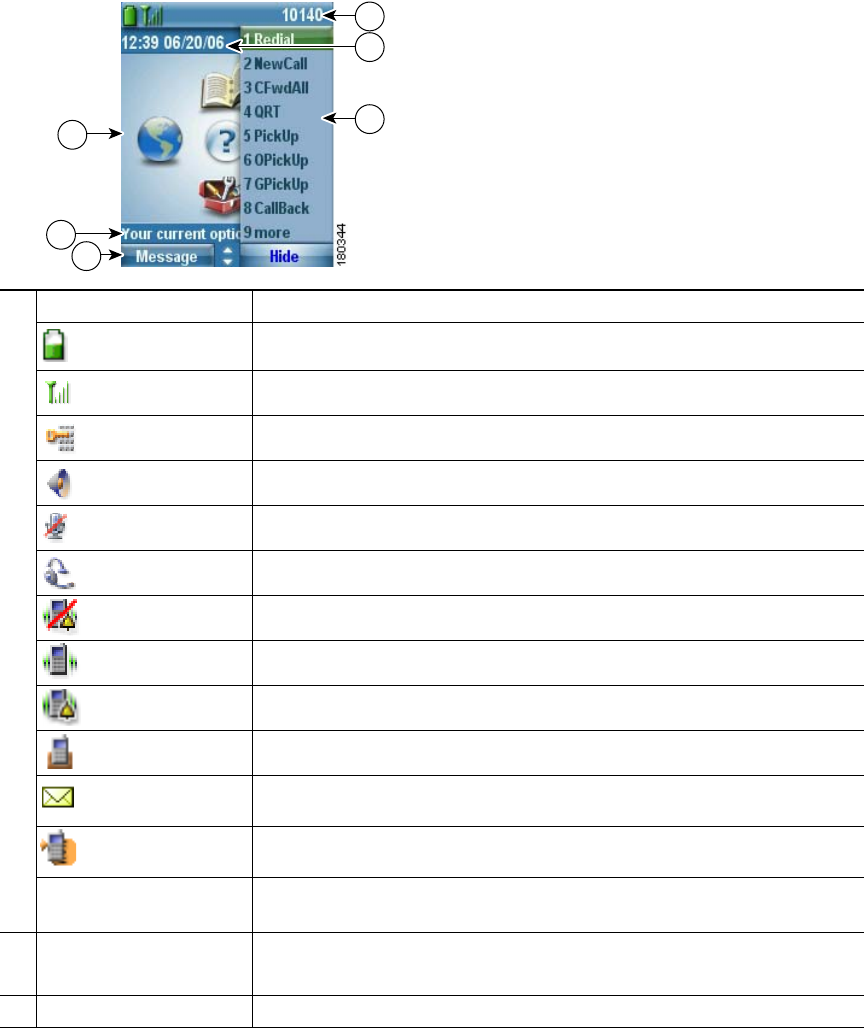
18 OL-10806-01
FINAL REVIEW - Cisco Confidential
1Phone Status line Displays these icons (if active) and your directory number:
Battery icon—Shows the level of charge in battery
Signal icon—Shows the degree of signal strength
Key lock icon—Indicates the keypad is locked
Speaker icon—Indicates speaker mode is active
Mute icon—Indicates mute is active
Headset icon—Indicates headset is plugged into phone
Ringer Off icon—Indicates the phone alert is silent
Vibrate icon—Indicates the phone alert is vibrate only
Vibrate and ring icon—Indicates the phone alert is ring and vibrate
Desk Top Charger icon—Indicates the phone is docked in the charger.
Voice Message icon—Indicates you have a voice message
Push to Talk icon—Indicates the Push to Talk feature is engaged
10140 Primary phone line—Displays the phone number (directory number)
for your primary phone line
2Date and Time line
12:39 06/20/06
Displays time and date information
3Options Menu Displays softkey features for the current call state
6
5
4
1
3
2
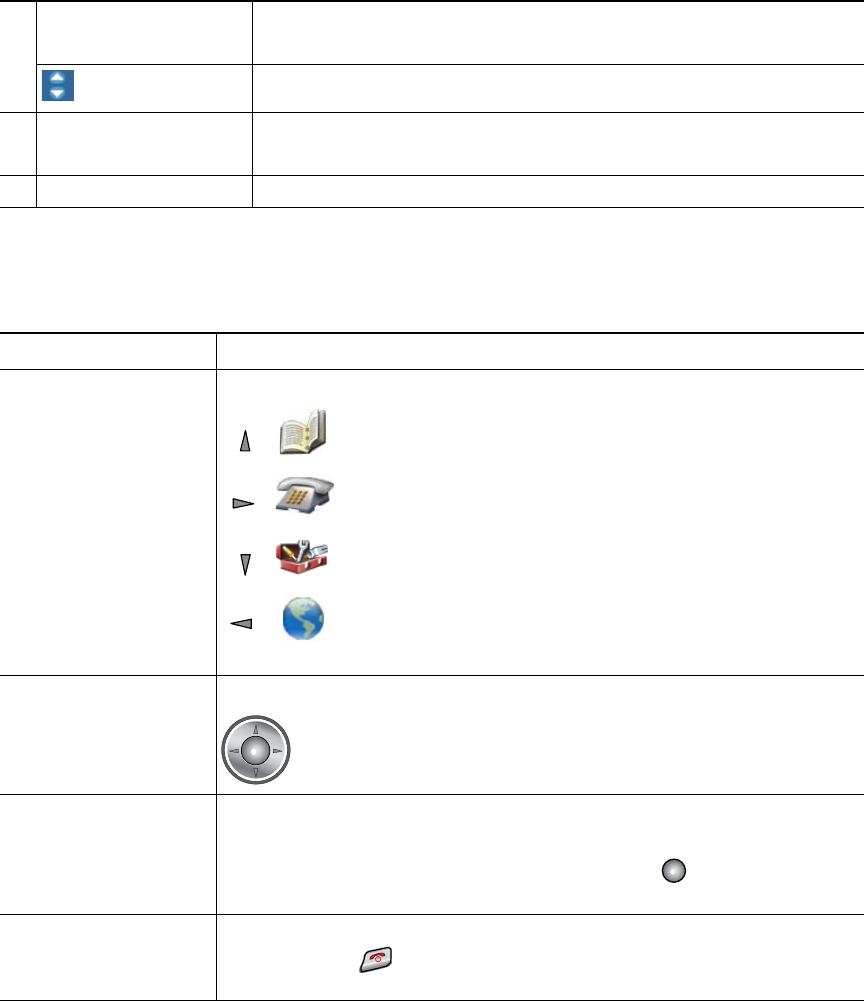
An Overview of Your Phone
Cisco Unified Wireless IP Phone 7921G for Cisco Unified CallManager 4.1, 4.2, 5.0 and Later 19
FINAL REVIEW - Cisco Confidential
Understanding Feature Buttons and Menus
Press a feature button to open or close a feature menu.
4Softkey labels area
Message - Hide
Displays softkey options and provides access to the Options list of
softkey features.
Displays the active navigation arrows for the menu or screen.
5Status and information
Your current options
Provides phone status or instructions
6Main phone screen Displays four menu icons and Help
If you want to... Then...
Open a feature menu Use the Navigation button to press one of these arrows that open a menu:
(Directory)
(Line View)
(Settings)
(Services)
Scroll through a menu
or list
Press the Navigation button up or down.
Select a menu option Do one of these:
•Press the keypad number key for the item.
•Scroll to highlight the item, and then press the button (center of
the navigation button).
Go back one level in a
feature menu
Press Back.
Note Pressing (red button) from any level of a menu closes the menu
and returns you to the main screen.
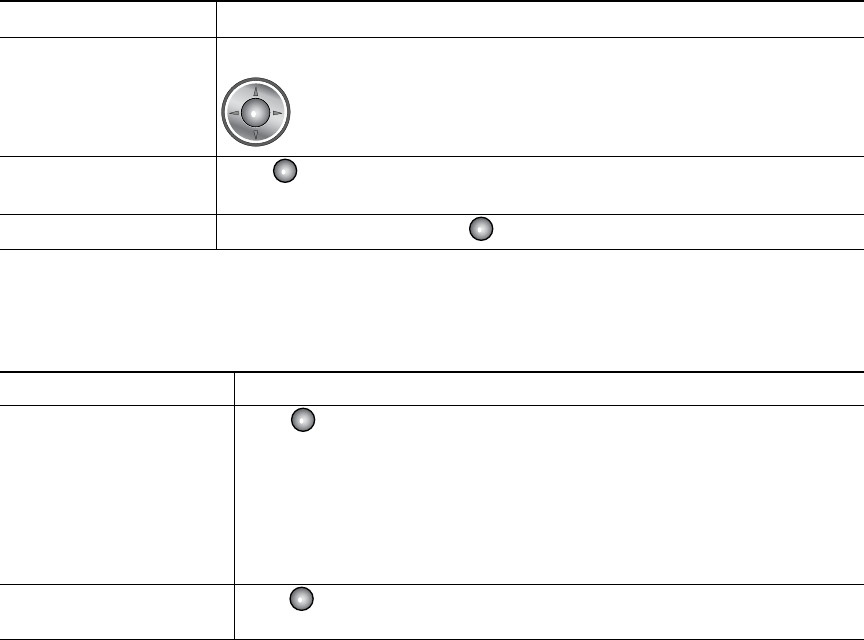
20 OL-10806-01
FINAL REVIEW - Cisco Confidential
Understanding the Help System on Your Phone
Your phone provides an online help system. Help topics appear on the screen.
Reposition the cursor
to edit a phone number
or name
Press the Navigation button left or right.
Select a highlighted call
or option
Press .
Access Help From the main screen, press .
If you want to... Then...
View the main menu Press and wait a few seconds for the menu to display. Main menu
topics include:
•About Your Cisco Unified IP Phone—Details about your phone
•How do I...?—Procedures for common phone tasks
•Calling Features—Descriptions and procedures for calling features
•Help—Tips on using and accessing Help
Get help using Help Press , wait for the online help main menu to display, and then choose
Help.
If you want to... Then...
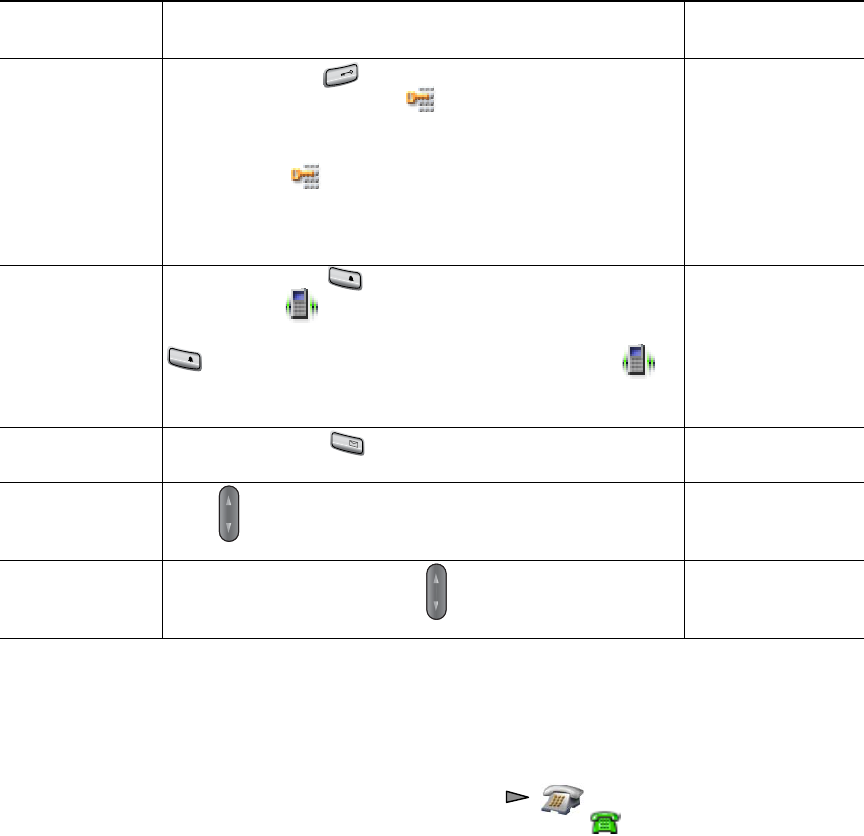
An Overview of Your Phone
Cisco Unified Wireless IP Phone 7921G for Cisco Unified CallManager 4.1, 4.2, 5.0 and Later 21
FINAL REVIEW - Cisco Confidential
Using Phone Buttons
The phone keypad and buttons provide these shortcuts to frequently used functions.
Understanding Lines vs. Calls
To avoid confusion about lines and calls, refer to these descriptions:
•Lines—Each corresponds to a directory number that others can use to call you. Your phone
supports up to six lines. To see your phone lines, press to open Line View. You have as
many lines as you have directory numbers with phone line icons in the Line View list.
•Calls—Each line can support multiple calls. Your phone supports up to 24 connected calls, but
your phone administrator can adjust this number according to your needs. Only one call can be
active at any time; other calls are automatically placed on hold.
If you want to... Then...
For more
information, see...
Lock or unlock
the phone
keypad
Press and hold the key (3 seconds). The screen displays
“Keypad Locked!” and the icon displays at the top of
the Main screen.
Press any key and the screen displays “Unlock Keypad?”
Press Yes, the icon disappears and the screen displays
“Keypad Unlocked!” or press No to retain the keypad lock.
Note The keypad lock is temporarily disabled when you have
an incoming call.
Setting the Keypad
to Automatically
Lock, page 49
Toggle between
ringing and
vibrating mode
Press and hold the key. The screen displays “Vibrate
On!” and the icon displays at the top.
To switch back to the ring mode, press and hold the
key. The screen displays “Vibrate Off!” and the
icon disappears.
Note You can use the Volume button to set vibrate also.
Customizing Rings,
page 45
Listen to voice
messages
Press and hold the key. The phone connects to your
voice messaging system.
Accessing Voice
Messages, page 56
Adjust the
volume during a
call
Press for a call on the handset, speaker, or headset. Using Phone
Buttons, page 21
Change the ring
pattern for your
calls
When the phone is idle, press to set the ring volume,
vibrate, or silent mode.
Customizing Rings,
page 45
#
*
*
1
@
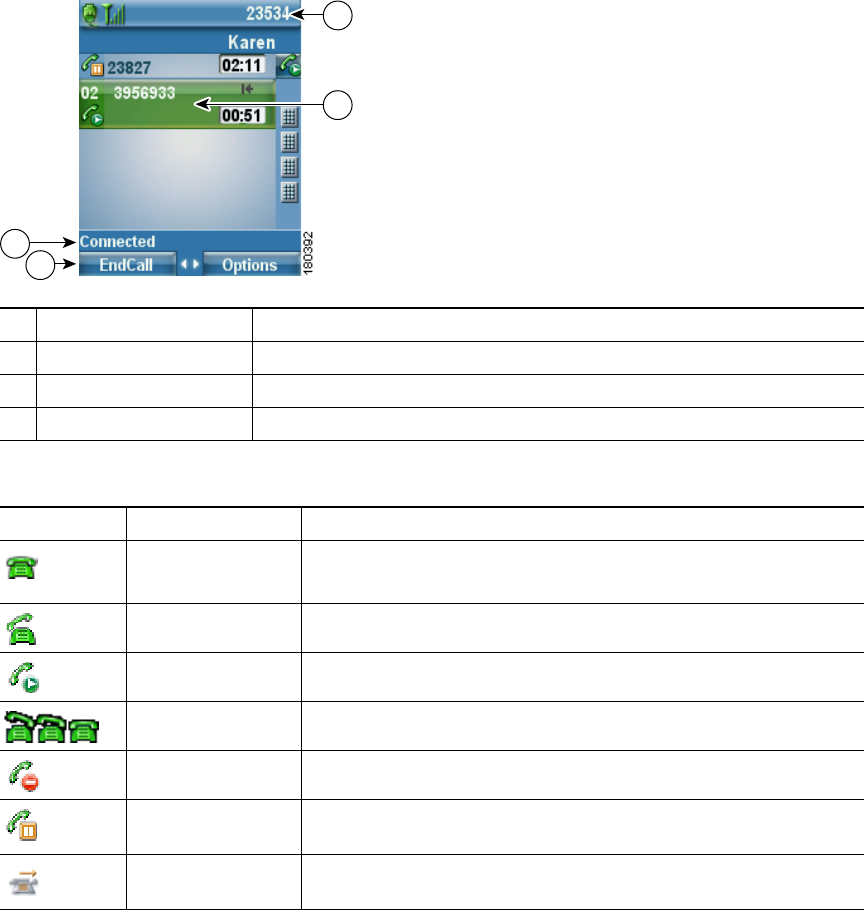
22 OL-10806-01
FINAL REVIEW - Cisco Confidential
Understanding Line and Call Icons
This is what your main phone screen looks like with two active calls, one on hold (23827) and another
connected (3956933).
Your phone displays these icons to help you determine the line and call state.
1Phone Status line Icons and your directory number
2Call Activity area Calling party information, connection duration, and call state icon
3Status line Status of the selected line
4Softkey labels Call feature and Options list
Icon Line or call state Description
On-hook line No call activity on this line.
Off-hook line Line in use, but not connected to a call.
Connected call You are connected to the other party.
Incoming call A call is ringing on one of your lines.
Remote line in use A shared line is in use remotely.
Call on hold You have put this call on hold. See Using Hold and Resume,
page 28.
Call forward
enabled
You have forwarded your primary line. See Forwarding All Calls
to Another Number, page 31.
3
4
1
2
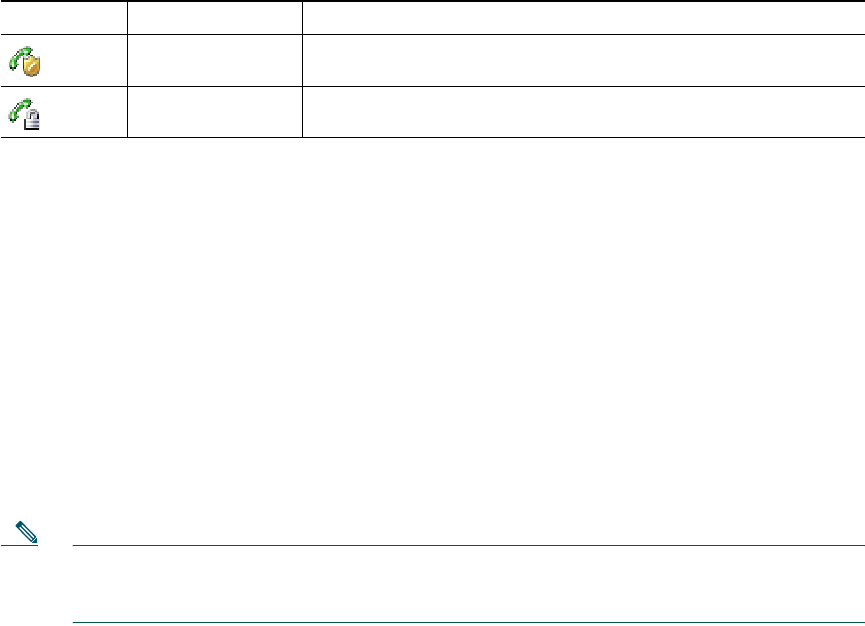
An Overview of Your Phone
Cisco Unified Wireless IP Phone 7921G for Cisco Unified CallManager 4.1, 4.2, 5.0 and Later 23
FINAL REVIEW - Cisco Confidential
Understanding Feature Availability
The operation of your Cisco Unified Wireless IP Phone 7921G and the features available to you may
vary, depending on the call processing agent used by your company and also on how your company’s
phone support team has configured your phone system. Therefore, some of the features included in
this guide might not be available to you or might work differently on your phone system. Contact your
support desk or phone administrator for information about feature operation or availability.
Cleaning the Phone
Gently wipe the phone screen and phone with a soft, dry cloth. Do not use any liquids or powders on
the phone. Using anything other than a soft, dry cloth can contaminate phone components and cause
failures.
Note If you need to clean or disinfect your phone, you can purchase a silicon cover for your
Cisco Unified Wireless IP Phone 7921G. For more information, refer to the Cisco Unified
Wireless IP Phone 7921G Accessory Guide.
Authenticated call See Making and Receiving Secure Calls, page 40.
Encrypted call See Making and Receiving Secure Calls, page 40.
Icon Line or call state Description
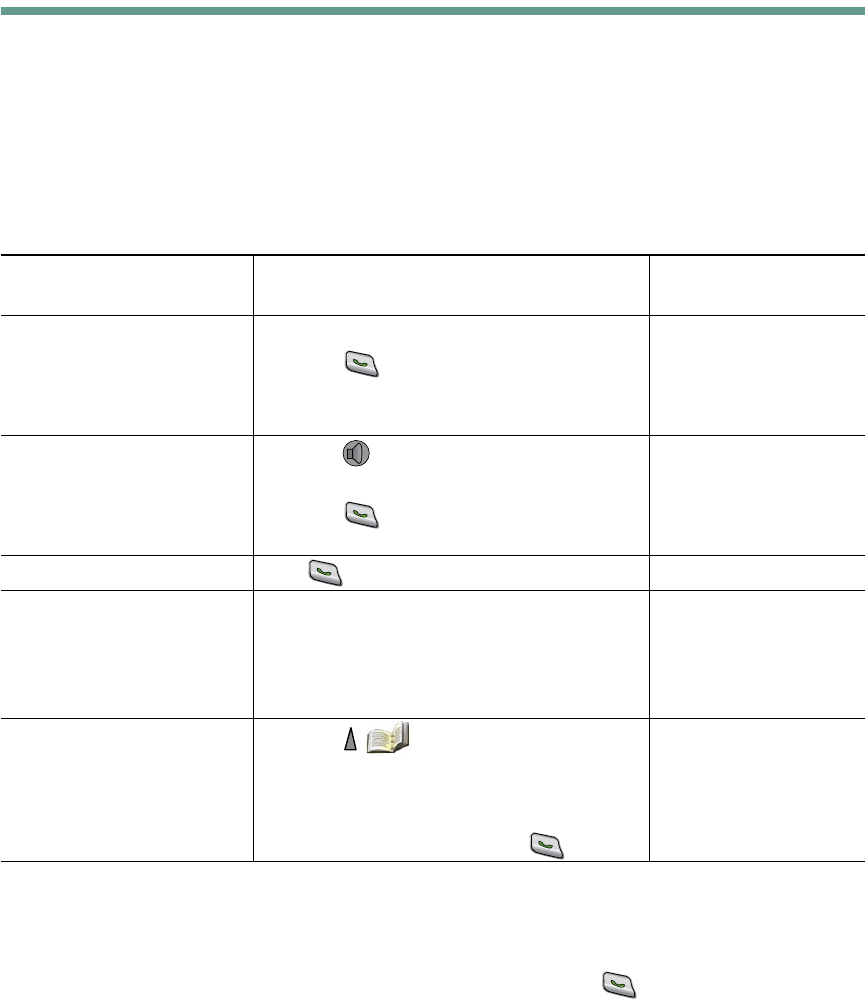
24 OL-10806-01
FINAL REVIEW - Cisco Confidential
Basic Call Handling
You can perform basic call-handling tasks using a range of features and services. Feature availability
can vary; see your phone administrator for more information.
Placing a Call—Basic Options
Here are some easy ways to place a call on your wireless IP phone.
Tips
•When you start to dial a number, your phone tries to anticipate the number you are dialing by
displaying matching numbers from your Placed Calls log. This is called Auto Dial. To call a
number displayed with Auto Dial, scroll to the number and press .
If you want to... Then...
For more information,
see...
Place a call using the
handset
1. Dial the phone number
2. Press (green button) to place your
call.
Note There is no dial tone.
Answering a Call,
page 27
Place a call using the
speaker mode on the
handset
1. Press button to activate the speaker.
2. Dial the phone number
3. Press (green button) to place your
call.
Using a Handset,
Headset, and
Speakerphone, page 43
Redial a number Press twice or choose Options > Redial.
Place a call while another
call is active (using the same
line)
1. Choose Hold.
2. Choose Options > NewCall.
3. Dial, redial, or speed dial a number.
Note You hear dial tone with NewCall.
Using Hold and
Resume, page 28
Dial from a call log 1. Press (Directory).
2. Choose Missed Calls, or Received Calls,
or Placed Calls.
3. Press the number key for the listing or
scroll to a listing and press .
Using Call Logs,
page 51
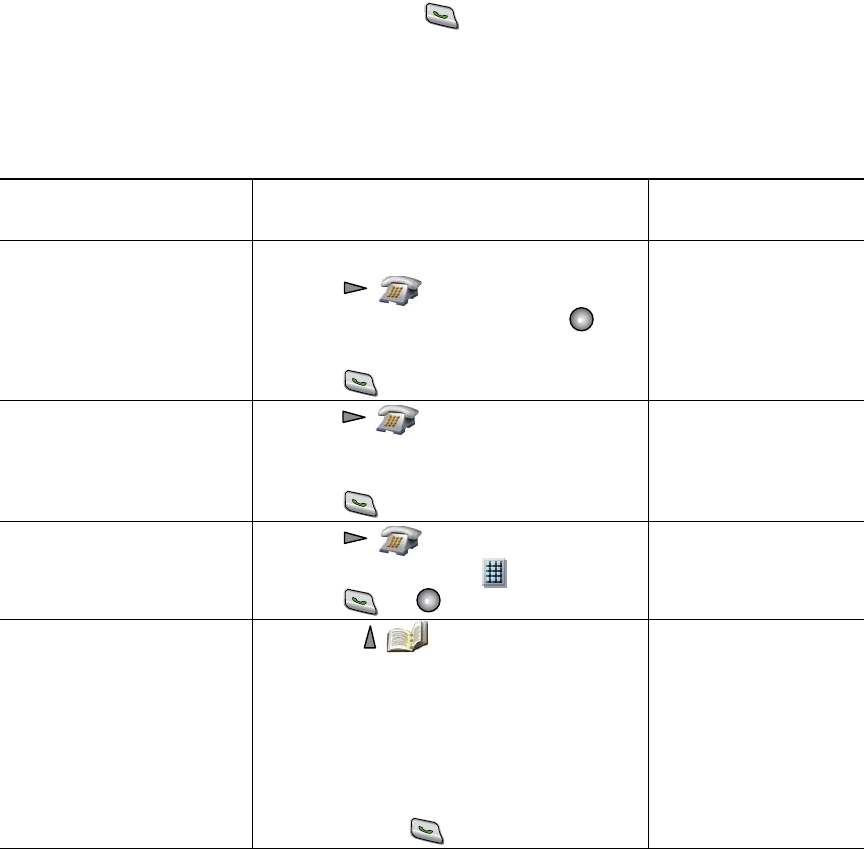
Basic Call Handling
Cisco Unified Wireless IP Phone 7921G for Cisco Unified CallManager 4.1, 4.2, 5.0 and Later 25
FINAL REVIEW - Cisco Confidential
•If you make a mistake while dialing, press << to erase digits.
•To redial the last number, you can also press two times.
Placing a Call—Additional Options
You can place calls using special features and services that might be available on your phone. See your
phone administrator for more information about these additional options.
If you want to... Then...
For more information,
see...
Place a call while another
call is active (using a
different line)
1. Press Hold.
2. Press (Line View).
3. Scroll to another line and press .
4. Dial a number.
5. Press to make the call.
Using Hold and
Resume, page 28
Place the call on a
secondary line
1. Press (Line View) and scroll to
another line.
2. Dial a number.
3. Press to make the call.
Switching Between
Multiple Calls, page 29
Speed dial a phone number 1. Press (Line View).
2. Scroll to a speed dial .
3. Press or
. to make the call.
Speed Dialing, page 35
Dial from a corporate
directory on your phone
1. Choose (Directory)> Directory
Services > Corporate Directory (name
can vary).
2. Use your keypad to enter a name.
3. Press Options > Submit.
4. Press the number key for the listing or
scroll to a listing
5. Press Dial or .
Directory Dialing,
page 51
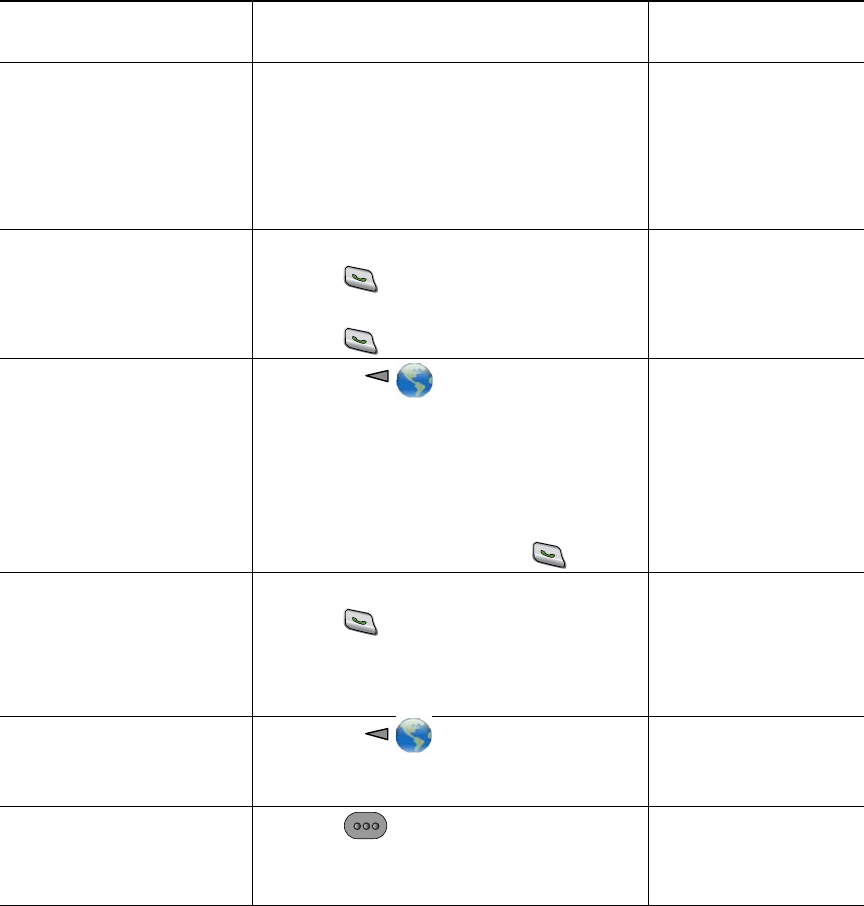
26 OL-10806-01
FINAL REVIEW - Cisco Confidential
Use Cisco CallBack to
receive notification when a
busy or ringing extension is
available
1. Choose Options > CallBack while
listening to the busy tone or ring sound.
2. Disconnect. Your phone alerts you when
the line is free.
3. Press Dial to place the call when the line
is available.
Your phone
administrator
Make a priority
(precedence) call
1. Enter the MLPP access number.
2. Press .
3. Dial the phone number.
4. Press .
Prioritizing Critical
Calls, page 41
Dial from a Personal
Address Book (PAB) entry
1. Choose (Services) > PAB
Service.
2. Enter login information.
3. Select Personal Address Book.
4. Use your keypad to enter a name.
5. Press Options > Submit.
6. Scroll to a listing and press .
Directory Dialing,
page 51
Place a call using a billing or
tracking code
1. Dial a number.
2. Press .
3. After the tone, enter a client matter code
(CMC) or a forced authorization code
(FAC).
Your phone
administrator
Place a call using your
Extension Mobility profile
1. Choose (Services) > EM Service
(name can vary).
2. Enter log in information.
Using Cisco Extension
Mobility, page 42
Place a Push to Talk call. 1. Press .
2.
Add instructions and xref here
Using Push to Talk
Service, page 43
If you want to... Then...
For more information,
see...

Basic Call Handling
Cisco Unified Wireless IP Phone 7921G for Cisco Unified CallManager 4.1, 4.2, 5.0 and Later 27
FINAL REVIEW - Cisco Confidential
Answering a Call
You can answer a call by using several options, if they are available on your phone.
Tips
•To use any button to answer a call, see Changing Keypad Settings, page 48.
•You can answer an incoming call even when the keypad is locked.
If you want to... Then... For more information, see...
Answer a call Press and release (green button)
to connect to the incoming call.
Using Any Key to Answer the
Phone, page 49
Silence the ring for an
incoming call
Press (red button) to forward the
call to your voice messaging system.
Or, to silence the ringing, press .
The call continues silently, then
forwards to the no answer target.
Switch from a connected
call to answer a ringing call
Press or (green button).
Doing so answers the new call and
automatically puts the first call on
hold.
Switching Between Multiple
Calls, page 29
Answer using call waiting Press Answer.
Send call directly to your
voice messaging system
Press iDivert or (red button). Accessing Voice Messages,
page 56
Retrieve a parked call on
another phone
Use Call Park. Storing and Retrieving Parked
Calls, page 39
Use your phone to answer a
call ringing elsewhere
Use Call Pickup. Picking Up Redirected Calls
on Your Phone, page 36
Answer a priority call Disconnect the current call and press
Answer or .
Prioritizing Critical Calls,
page 41
Automatically connect to an
incoming call after a ring or
two
Ask your phone administrator to set
up the Auto Answer feature. After
ringing once or twice, the call
automatically connects to the handset
or headset without pressing .
Using AutoAnswer, page 44

28 OL-10806-01
FINAL REVIEW - Cisco Confidential
Ending a Call
To end a call, simply disconnect.
Using Hold and Resume
You can hold and resume calls A held call is indicated by the call-on-hold icon in the call view.
If you want to... Then...
End the call Choose (red button), EndCall, or Options > EndCall.
Disconnect one call, but preserve
another call on the same line
Choose EndCall or Options > EndCall. If necessary, remove
the call from hold first.
If you want to... Then...
Put a call on hold 1. Make sure the call you want to put on hold is highlighted.
2. Press Hold.
Note Engaging the Hold feature typically generates music or a beeping
tone.
Remove a call from
hold on the current line
1. Make sure the appropriate call is highlighted.
2. Press Resume.
Remove a call from
hold on a different line
1. Press (Line View) to change to another line.
2. Press Resume.
Note If a single call is holding on this line, the call automatically resumes. If
another call is holding, scroll to the appropriate call and press Resume.
Move a call on a shared
line to your wireless
phone or to your desk
phone
1. From the phone with the active call on the shared line, press Hold.
2. From your other phone with the shared line, press Resume.
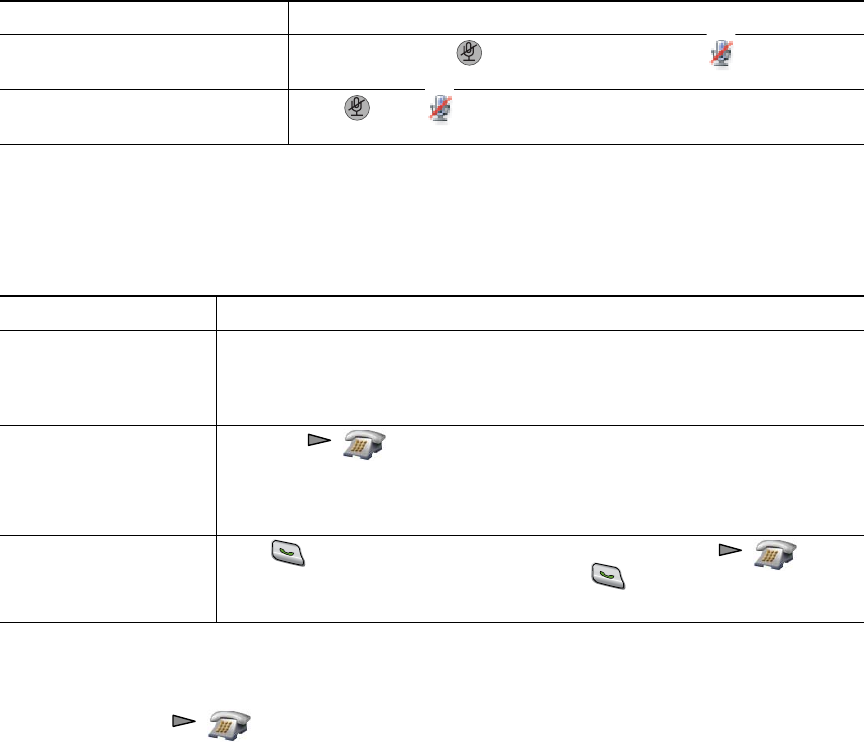
Basic Call Handling
Cisco Unified Wireless IP Phone 7921G for Cisco Unified CallManager 4.1, 4.2, 5.0 and Later 29
FINAL REVIEW - Cisco Confidential
Using Mute
With Mute enabled, you can hear other parties on a call but they cannot hear you. You can use Mute
in conjunction with the phone or a headset.
Switching Between Multiple Calls
You can switch between multiple calls on one or more lines. If the call that you want to switch to is
not automatically highlighted on the phone screen, scroll to it.
Tips
•The phone can have up to six lines, but the phone screen displays only one line. To see other lines,
you must press (Line View).
•The phone can have multiple calls per line, but no more than 24 calls per phone.
If you want to... Then...
Toggle Mute on During a call, press on left side of phone. The icon displays
at the top of the phone screen.
Toggle Mute off Press . The icon disappears.
If you want to... Then...
Switch between
connected calls on one
line
1. Make sure the call that you want to switch to is highlighted.
2. Press Resume.
Any active call is placed on hold and the selected call is resumed.
Switch between
connected calls on
different lines
1. Press (Line View) to change to another line.
2. If a single call is holding on the line, the call automatically resumes. If
another call is holding, scroll to highlight the appropriate call and
press Resume.
Switch from a
connected call to
answer a ringing call
Press , or if the call is ringing on a different line, press (Line
View) to switch to the other line and press .
Any active call is placed on hold.

30 OL-10806-01
FINAL REVIEW - Cisco Confidential
Transferring Calls
Transfer redirects a connected call. The target is the number to which you want to transfer the call.
Tips
•If on-hook transfer is enabled on your phone, you can either disconnect to complete the transfer,
or choose Options > Trnsfer and then disconnect.
•If on-hook transfer is not enabled on your phone, disconnecting without using Trnsfer again places
the call on hold.
•You cannot use Trn sfer to redirect a call on hold. Choose Options > Resume to remove the call
from hold before transferring it.
If you want to... Then...
Transfer a call without
talking to the transfer
recipient
1. From an active call, choose Options >Trnsfer.
2. Dial the target number.
3. Choose Options > Trnsfer again to complete the transfer or
EndCall to cancel.
Note If your phone supports on-hook transfer, you can alternately
complete the transfer by disconnecting.
Talk to the transfer
recipient before transferring
a call (consult transfer)
1. From an active call, choose Options > Trnsfer.
2. Dial the target number.
3. Wait for the transfer recipient to answer.
4. Choose Options > Trnsfer again to complete the transfer or
EndCall to cancel.
Note If your phone supports on-hook transfer, you can alternately
complete the transfer by disconnecting.
Transfer two current calls
to each other
(direct transfer) without
staying on the line
1. Scroll to highlight any call on the same line.
2. Choose Options > Select. A displays by the selected call.
3. Scroll to highlight the other call on the same line.
4. Choose Options > DirTrfr.
The two calls connect to each other and drop you from the call.
Note If you want to stay on the line with the callers, use Join instead.
Redirect a call to your voice
messaging system
Choose Options > iDivert.
The call is automatically transferred to your voice message greeting.
You can use iDivert with a call that is active, ringing, or on hold.
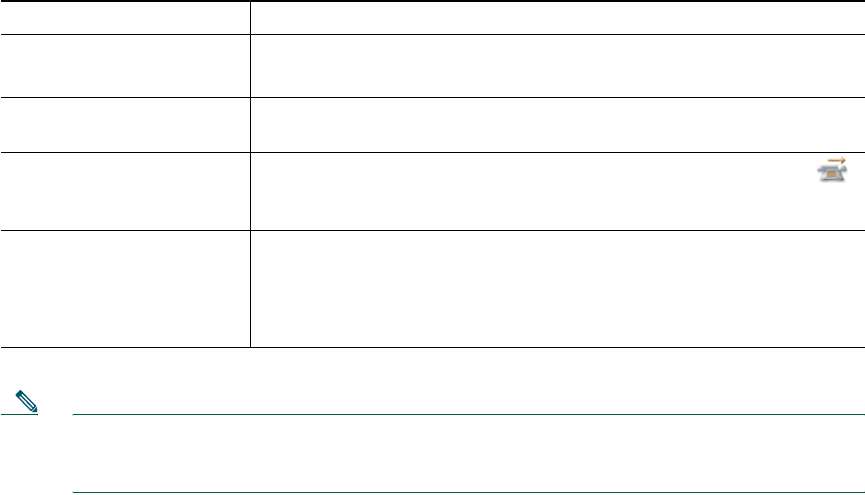
Basic Call Handling
Cisco Unified Wireless IP Phone 7921G for Cisco Unified CallManager 4.1, 4.2, 5.0 and Later 31
FINAL REVIEW - Cisco Confidential
Forwarding All Calls to Another Number
You can use Call Forward All to redirect incoming calls from your phone to another number.
Note When call forwarding is enabled for any line other than the primary line, your phone does not
provide you with confirmation that calls are being forwarded. Instead, you must confirm your
settings in the User Options web pages.
Tips
•Enter the call forward target number exactly as you would dial it from your phone. For example,
enter an access code or the area code, if necessary.
•You can forward your calls to a traditional analog phone or to another IP phone, although your
phone administrator might restrict the call forwarding feature to numbers within your company.
•Call forwarding is phone line specific. If a call reaches you on a line where call forwarding is not
enabled, the call will ring as usual.
•Your phone administrator can change forwarding conditions for your phone lines.
If you want to... Then...
Set up call forwarding on
your primary line
1. Choose Options > CFwdAll.
2. Enter a target phone number.
Cancel call forwarding on
your primary line
Choose Options > CFwdAll.
Verify that call forwarding
is enabled on your primary
line
Look for the call forward target number in the status line and the
icon next to the primary line.
Set up or cancel call
forwarding for any line on
your phone.
1. Log in to your User Options web pages. See Accessing Your
User Options Web Pages, page 59.
2. Choose Forward all calls...
3. Choose your primary line or any secondary line.

32 OL-10806-01
FINAL REVIEW - Cisco Confidential
Making Conference Calls
Your Cisco Unified IP Phone allows you to join three or more people into one telephone conversation,
creating a conference call.
Understanding Types of Conference Calls
There are two types of conference calls: Standard (ad hoc) and Meet-Me.
Standard Conference Calls
You can create a standard (ad hoc) conference in different ways, depending on your needs and the
softkeys available on your phone:
•Confrn—Use this softkey to establish a standard conference by calling each participant. Standard
conference calling is a default feature available on most phones.
•Join—Use this softkey to establish a standard conference by joining several calls already on one
line.
•cBarge—Use this softkey to add yourself to an existing call on a shared line and to turn the call
into a standard conference call. This feature is available only on phones that use shared lines.
See Starting and Joining a Standard Conference, page 32 for additional instructions.
Meet-Me Conference Calls
You can create a Meet-Me conference by calling the Meet-Me phone number at a specified time.
See Starting or Joining a Meet-Me Conference Call, page 34 for additional instructions.
Starting and Joining a Standard Conference
A standard conference allows at least three participants to talk on a single call.
If you want to... Then...
•Create a conference by
calling participants
•Add new participants to
an existing conference
1. From a connected call, choose Options > Confrn.
2. Enter the participant’s phone number.
3. Wait for the call to connect.
4. Choose Options > Confrn again to add the participant to your
call.
5. Repeat to add additional participants.
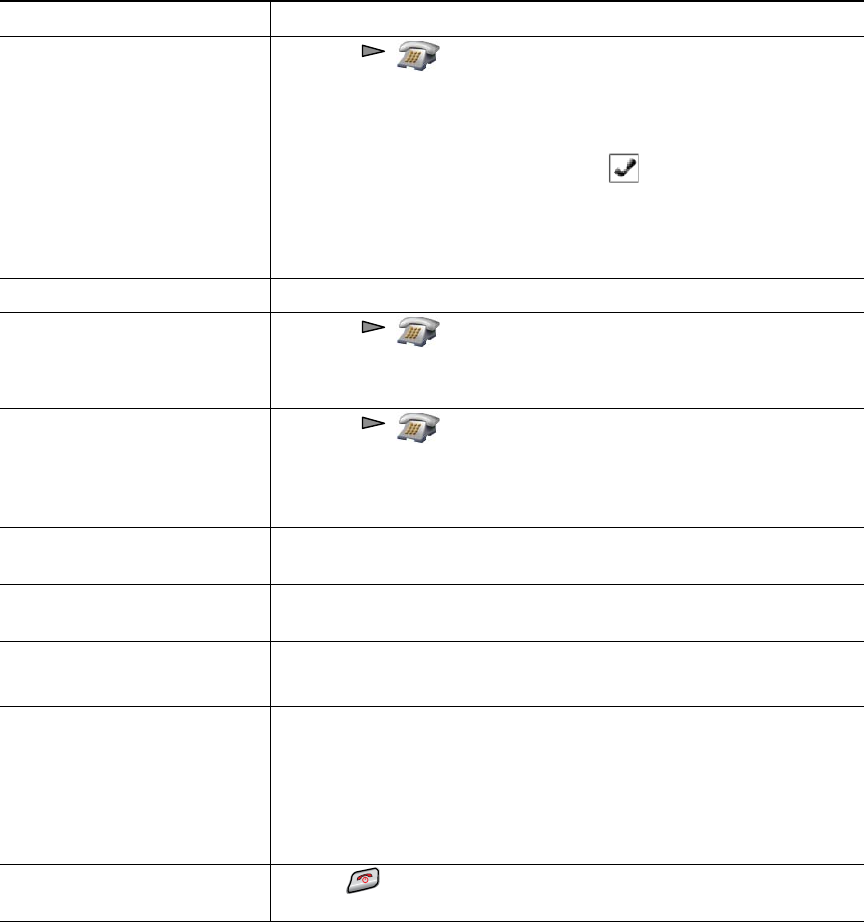
Basic Call Handling
Cisco Unified Wireless IP Phone 7921G for Cisco Unified CallManager 4.1, 4.2, 5.0 and Later 33
FINAL REVIEW - Cisco Confidential
Create a conference by joining
two or more existing calls
1. Press (Line View) to make sure that you have two or
more calls on a single line.
2. Scroll to a call that you want to add to the conference.
3. Choose Options > Select.
The selected call displays this icon .
4. Repeat this process for each call that you want to add.
5. From the selected call, choose Options > Join.
Note The active call is automatically selected.
Participate in a conference Answer the phone when it rings.
Create a conference by
barging a call on a shared line
1. Press (Line View) to select a call on a shared line.
2. Choose Options > cBarge.
See Using a Shared Line, page 37.
View a list of conference par-
ticipants
1. Press (Line View) to select an active conference.
2. Choose Options > ConfList.
Participants are listed in the order in which they join the
conference with the most recent additions at the top.
Get an updated list of partici-
pants
While viewing the conference list, choose Options > Update.
See who started the confer-
ence
While viewing the conference list, locate the person listed at the
bottom of the list with an asterisk (*) next to the name.
Drop the last party added to
the conference
While viewing the conference list, choose Options > RmLstC.
You can remove participants only if you initiated the conference call.
Remove any conference par-
ticipant
1. Highlight an active conference.
2. Choose Options > Conflist.
3. Scroll to highlight the participant’s name.
4. Choose Options > Remove.
You can remove participants only if you initiated the conference.
End your participation in a
conference
Choose (red button), EndCall or Options > EndCall.
If you want to... Then...

34 OL-10806-01
FINAL REVIEW - Cisco Confidential
Tips
•Calls must be on the same line before you can add them to a conference. If calls are on different
lines, transfer them to a single line before using Confrn or Join.
•Depending on how your phone is configured, if you leave a conference after initiating it, the
conference might end. To avoid this, transfer the conference before hanging up.
Starting or Joining a Meet-Me Conference Call
Meet-Me conferencing allows you to start (initiate) or join a conference by dialing the conference
number.
If you want to... Then...
Start a Meet-Me conference 1. Obtain a Meet-Me phone number from your phone administrator.
2. Distribute the number to participants.
3. When you are ready to start the meeting, choose Options >
MeetMe.
4. Dial the Meet-Me conference number.
5. Press the (green button).
Participants can now join the conference by dialing in.
Note Participants hear a busy tone if they call the conference before the
initiator has joined. In this case, participants must call back.
Participate in a Meet-Me
conference
1. Dial the Meet-Me conference number (provided by the conference
initiator).
2. Press the (green button).
Note You will hear a busy tone if you call the conference before the
initiator has joined. In this case, try your call again.
End a Meet-Me conference All participants must hang up.
The conference does not automatically end when the conference
initiator disconnects.

Advanced Call Handling
Cisco Unified Wireless IP Phone 7921G for Cisco Unified CallManager 4.1, 4.2, 5.0 and Later 35
FINAL REVIEW - Cisco Confidential
Advanced Call Handling
Advanced call-handling tasks involve special features that your phone administrator might configure
for your phone depending on your call-handling needs and work environment.
Speed Dialing
Speed dialing allows you to press a key, select a Line View item, or use an index number to place a call.
Depending on configuration, your phone can support several speed-dial features:
•Speed Dial in your Line View
•Speed Dialing and Abbreviated Dialing
•Fast Dials
Note • To set up speed dial and Abbreviated Dial, you must access your User Options web pages.
See Accessing Your User Options Web Pages, page 57.
•To set up Fast Dials, you must have access to the Personal Directory feature. See Using
Personal Directory on the Web, page 61.
•Alternately, your phone administrator can configure speed-dial features for you.
Using Speed Dial and Fast Dial
You must set up speed-dial features on your User Options web pages before you can use this feature.
See Accessing Your User Options Web Pages, page 57.
If you want to... Then...
Use speed-dial
numbers
1. Set up speed-dial numbers from your User Options web pages.
2. To place a call, press (Line View).
3. Scroll to a speed-dial number with its label.
4. Press .
Note The Line View displays your directory numbers, followed by your speed-dial
numbers identified with . Six items (lines plus speed dials) can display.

36 OL-10806-01
FINAL REVIEW - Cisco Confidential
Picking Up Redirected Calls on Your Phone
Call PickUp allows you to answer a call that is ringing on a co-worker’s phone by redirecting the call
to your phone. You might use Call PickUp if you share call-handling with co-workers.
Tips
•Depending on how your phone is configured, you might receive an audio and/or visual alert about
a call to your pickup group.
Use Abbreviated
Dial
1. Set up Abbreviated Dialing codes from your User Options web pages.
2. To place a call, enter the Abbreviated Dialing code.
3. Choose Options > AbbrDial.
Use Fast Dial 1. Subscribe to the Fast Dial service and set up Fast Dial codes from your User
Options web pages. See Accessing Your User Options Web Pages, page 57.
2. To place a call, choose (Services) > Fast Dial service on your phone
(exact name might vary).
3. Scroll to a listing and press .
If you want to... Then...
Answer a call that is ringing on
another extension within your call
pickup group
1. Choose Options > PickUp.
If your phone supports auto-pickup, you are now
connected to the call.
2. If the call rings on your phone, press Answer to connect
to the call.
Answer a call that is ringing on
another extension outside of your
group
1. Choose Options > GPickUp (if available).
2. Enter the group pickup code.
If your phone supports auto-pickup, you are now
connected to the call.
3. If the call rings on your phone, press Answer to connect
to the call.
Answer a call that is ringing on
another extension in your group or
in an associated group
1. Choose Options > OPickUp (if available).
If your phone supports auto-pickup, you are now
connected to the call.
2. If the call rings on your phone, press Answer to connect
to the call.
If you want to... Then...

Advanced Call Handling
Cisco Unified Wireless IP Phone 7921G for Cisco Unified CallManager 4.1, 4.2, 5.0 and Later 37
FINAL REVIEW - Cisco Confidential
•Pressing PickUp and GPickUp connects you to the call that has been ringing for the longest time.
•Pressing OPickUp connects you to the call in the pickup group with the highest priority.
•If you have multiple lines and want to pick up the call on a non-primary line, first press
(Line View) to switch to the desired line, then choose Options and a Call PickUp softkey.
Using a Shared Line
Your phone administrator might ask you to use a shared line if you:
•Have multiple phones and want one phone number
•Share call-handling tasks with co-workers
•Handle calls on behalf of a manager
Understanding Shared Lines
Remote-in-Use
The “In Use Remote” message and icon displays on a Cisco Unified Wireless IP Phone 7921G
when another phone that shares your line has a connected call and Privacy is disabled. You can place
and receive calls as usual on the shared line, even when the “In Use Remote” message or icon
displays.
Sharing Call Information and Barging
Phones that share a line each display information about calls that are placed and received on the shared
line. This information might include caller ID and call duration. (See the Privacy section for
exceptions.)
When call information is visible in this way, you and coworkers who share a line can add yourselves
to calls using either Barge or cBarge. See Adding Yourself to a Shared-Line Call, page 38.
Barge—Allows you to join a shared-line call with an IP phone that has the built-in bridge enabled.
cBarge—Allows you to join a shared-line call with any IP phone and convert the call to a conference.
Privacy
The Cisco Unified Wireless IP Phone 7921G has Privacy enabled by default. Co-workers, who share
your line, cannot see information about your calls. If you want co-workers who share your line to see
information, you must have the Privacy feature configured on your phone. See Preventing Others from
Viewing or Joining a Shared-Line Call, page 39.
Note The Cisco Unified Wireless IP Phone 7921G can support a maximum of 24 calls on a shared
line.

38 OL-10806-01
FINAL REVIEW - Cisco Confidential
Adding Yourself to a Shared-Line Call
Depending on how your phone is configured, you can add yourself to a call on a shared line using
either Barge or cBarge.
Tips
•If a phone that is using the shared line has Privacy enabled, call information and barge softkeys
will not appear on the other phones that share the line.
•You will be disconnected from a call that you have joined using Barge if the call is put on hold,
transferred, or turned into a conference call.
If you want to... Then...
See if the shared line is
in use
Look for the icon and the “In Use Remote” message.
Add yourself to a call
on a shared line using
the Barge softkey
1. Highlight a remote-in-use call. You might need to use Line View.
2. Choose Options > Barge. Other parties hear a beep tone announcing
your presence.
Add yourself to a call
on a shared line using
the cBarge softkey
1. Highlight a remote-in-use call.You might need to use Line View.
2. Choose Options > cBarge.
Other parties hear a tone and brief audio interruption, and call
information changes on the phone screen.
Add new conference
participants to a call
that you have barged
Barge the call using cBarge, if available.
Note cBarge converts the call into a standard conference call, allowing you
to add new participants. See Making Conference Calls, page 32.
Move a shared-line call
to another phone
Press Hold. On another phone with the same shared line, press Resume.
Leave a barged call Choose EndCall or .
If you disconnect after using Barge, the remaining parties hear a disconnect
tone and the original call continues.
If you disconnect after using cBarge, the call remains a conference call
(provided at least three participants remain on the line).
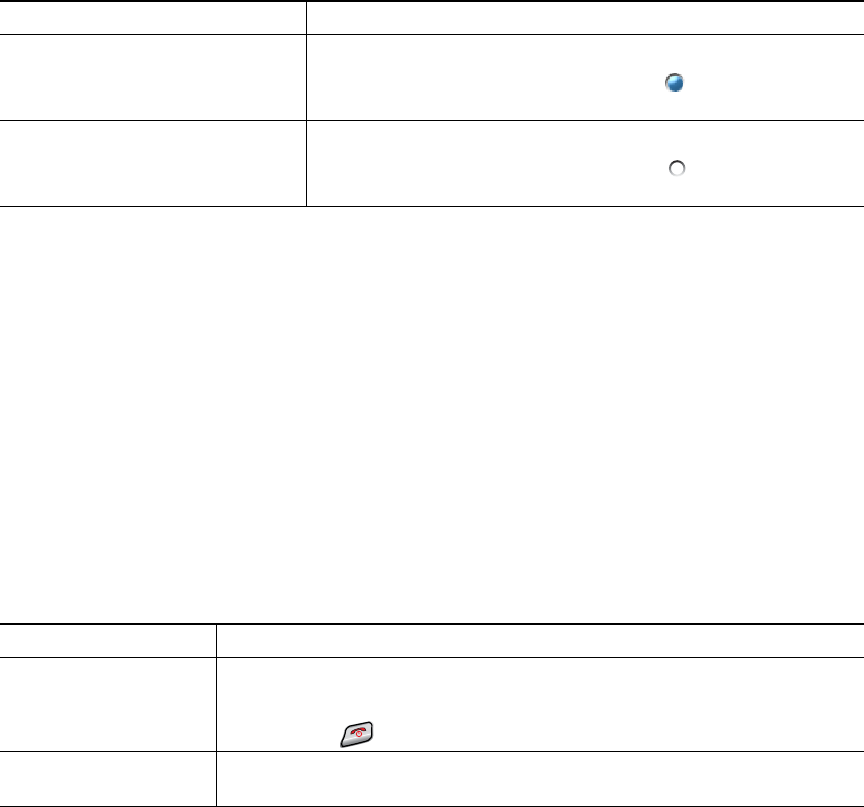
Advanced Call Handling
Cisco Unified Wireless IP Phone 7921G for Cisco Unified CallManager 4.1, 4.2, 5.0 and Later 39
FINAL REVIEW - Cisco Confidential
Preventing Others from Viewing or Joining a Shared-Line Call
If you share a phone line, you can use the Privacy feature to prevent others who share the line from
viewing or barging (adding themselves to) your calls.
Tips
•If the phone that shares your line has Privacy enabled, you can make and receive calls using the
shared line as usual.
•The Privacy feature applies to all shared lines on your phone. Consequently, if you have multiple
shared lines and Privacy is enabled, coworkers will not be able to view or barge calls on any of
your shared lines.
Storing and Retrieving Parked Calls
You can park a call when you want to store the call so that you or someone else can retrieve it from
another phone in the Cisco Unified CallManager system (for example, a phone in a conference room).
You can park a call by using the Park softkey to store the call. Your phone displays the call park
number where the system stored your call. You must record this number and then use the same number
to retrieve the call.
Tip
You have a limited amount of time to retrieve a parked call before it reverts to ringing at the original
number. See your phone administrator for details.
If you want to... Then...
Prevent others from viewing or
barging calls on a shared line
1. Choose Options > Private.
2. To verify that Privacy is on, look for (Privacy-enabled
icon) next to the directory number.
Allow others to view or barge calls
on a shared line
1. Choose Options > Private.
2. To verify that Privacy is off, look for (Privacy-disabled
icon) next to the directory number.
If you want to... Then...
Store an active call
using Call Park
1. During a call, choose Options > Park.
2. Note the call park number displayed on your phone screen.
3. Press the .
Retrieve a parked call Enter the call park number from any Cisco Unified IP Phone in your
network to connect to the call.
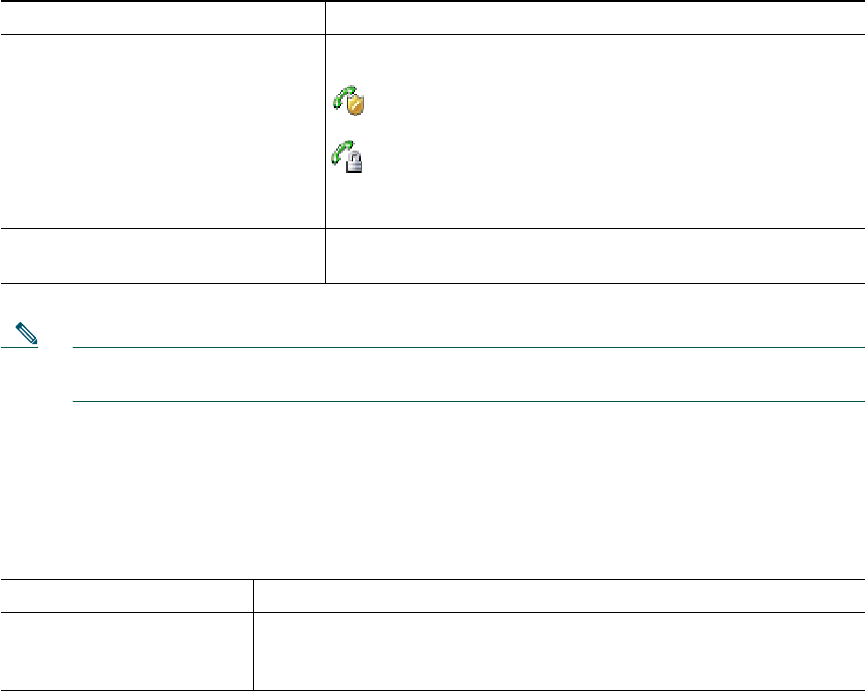
40 OL-10806-01
FINAL REVIEW - Cisco Confidential
Making and Receiving Secure Calls
Depending on how your phone administrator has configured your phone system, your phone might
support making and receiving secure calls.
Your phone is capable of supporting these types of calls:
•Authenticated call—The identities of all phones participating in the call have been verified.
•Encrypted call—The phone is receiving and transmitting encrypted audio (your conversation)
within the Cisco IP network. Encrypted calls are also authenticated.
•Non-secure call—At least one of the participating phones or the connection does not support these
security features, or the phones cannot be verified.
Note There are interactions, restrictions, and limitations that affect how security features work on
your phone. For more information, ask your phone administrator.
Tracing Suspicious Calls
If you are receiving suspicious or malicious calls, your phone administrator can add the Malicious Call
Identification (MCID) feature to your phone. This feature enables you to identify an active call as
suspicious, which initiates a series of automated tracking and notification messages.
If you want to... Then...
Check the security level of a call Look for a security icon in the top right corner of the call
activity area, next to the call duration timer:
Authenticated call
Encrypted call
Neither security icon appears if the call is non-secure.
Determine if secure calls can be
made in your company
Contact your phone administrator.
If you want to... Then...
Notify your phone
administrator about a
suspicious or harassing call
Choose Options > MCID.
Your phone plays a tone and displays the message, “MCID successful.”

Advanced Call Handling
Cisco Unified Wireless IP Phone 7921G for Cisco Unified CallManager 4.1, 4.2, 5.0 and Later 41
FINAL REVIEW - Cisco Confidential
Prioritizing Critical Calls
In some specialized environments, such as military or government offices, you might need to make and
receive urgent or critical calls. If you have the need for this specialized call handling, your phone
administrator can add Multilevel Precedence and Preemption (MLPP) to your phone.
Keep these terms in mind:
•Precedence indicates the priority associated with a call.
•Preemption is the process of ending an existing, lower priority call while accepting a higher
priority call that is sent to your phone.
Tips
•When you make or receive an MLPP-enabled call, you will hear special ring tones and call waiting
tones that differ from the standard tones.
•If you enter an invalid MLPP access number, a verbal announcement will alert you of the error.
If you... Then...
Want to choose a priority (precedence)
level for an outgoing call
Contact your phone administrator for a list of corresponding
precedence numbers for calls.
Want to make a priority (precedence)
call
Enter the MLPP access number (provided by your phone
administrator) followed by the phone number.
Hear a special ring (faster than usual)
or special call waiting tone
You are receiving a priority (precedence) call. An MLPP icon
on your phone screen indicates the priority level of the call.
Want to view priority level of a call Look for an MLPP icon on your phone screen:
Priority call
Medium priority (immediate) call
High priority (flash) call
Highest priority (flash override) or Executive
Override call
Higher priority calls are displayed at the top of your call list.
If you do not see an MLPP icon, the priority level of the call
is normal (routine).
Want to accept a higher-priority call Answer the call as usual. If necessary, end an active call first.
Hear a continuous tone interrupting
your call
You or the other party are receiving a call that must preempt
the current call. Disconnect immediately to allow the higher
priority call to ring through.
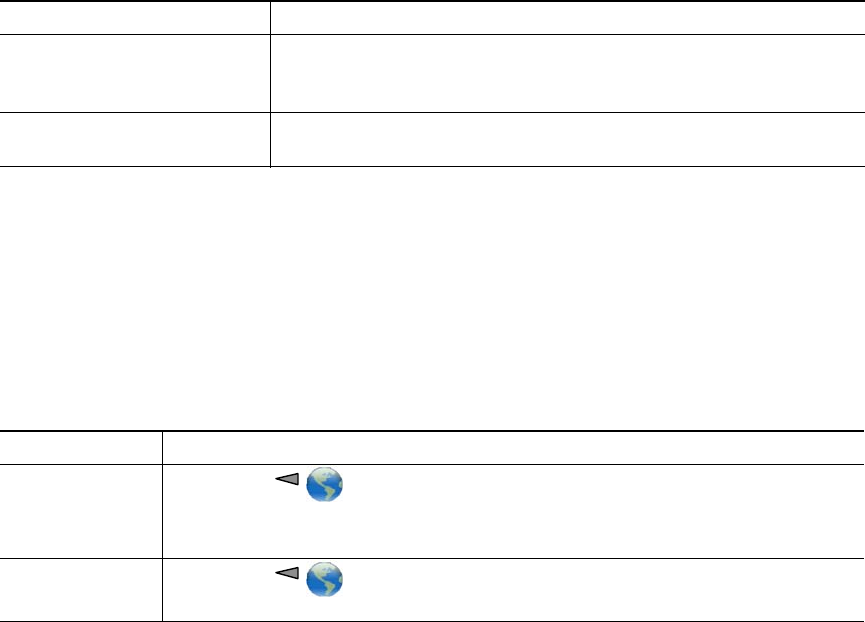
42 OL-10806-01
FINAL REVIEW - Cisco Confidential
Logging Out of Hunt Groups
If your organization receives a large number of incoming calls, you might be a member of a hunt group.
A hunt group includes a series of directory numbers that share the incoming call load. When the first
directory number in the hunt group is busy, the system hunts for the next available directory number
in the group and directs the call to that phone. When you are away from your phone, you can prevent
hunt group calls from ringing your phone by logging out of hunt groups.
Tip
Logging out of hunt groups does not prevent non-hunt group calls from ringing your phone.
Using Cisco Extension Mobility
Cisco Extension Mobility (EM) allows you to temporarily configure a Cisco Unified IP Phone as your
own. Once you log in to EM, the phone adopts your user profile, including your phone lines, features,
established services, and web-based settings. Your phone administrator must configure EM for you.
Tips
•EM automatically logs you out after a certain amount of time. This time limit is established by
your phone administrator.
•Changes that you make to your EM profile (from the User Options web pages) take effect the next
time that you log in to EM on a phone.
•Settings that are controlled on the phone only are not maintained in your EM profile.
If you want to... Then...
Log out of hunt groups to
temporarily block hunt group
calls
Choose Options > HLog. Your phone screen displays, “Logged out
of Hunt Group.”
Log in to receive hunt group
calls
Choose Options > HLog.
If you want to... Then...
Log in to EM 1. Choose (Services) > EM Service (name can vary).
2. Enter your user ID and PIN (provided by your phone administrator).
3. If prompted, select a device profile.
Log out of EM 1. Choose (Services) > EM Service (name can vary).
2. When prompted to log out, press Yes.

Advanced Call Handling
Cisco Unified Wireless IP Phone 7921G for Cisco Unified CallManager 4.1, 4.2, 5.0 and Later 43
FINAL REVIEW - Cisco Confidential
Using Push to Talk Service
If you need to be in immediate contact with members of your organization, you might use the Push to
Talk feature on your phone. For more information about your service and how to use it, contact your
phone administrator.
Tip
Any tips?
.
If you want to... Then...
Access the Push to Talk
service
1. Choose (Services) > Push to Talk (name can vary).
2. Enter your user ID and PIN (provided by your phone
administrator).
Do users log in?
Place a call using Push to Talk Press .
Answer a call Press .
44 OL-10806-01
FINAL REVIEW - Cisco Confidential
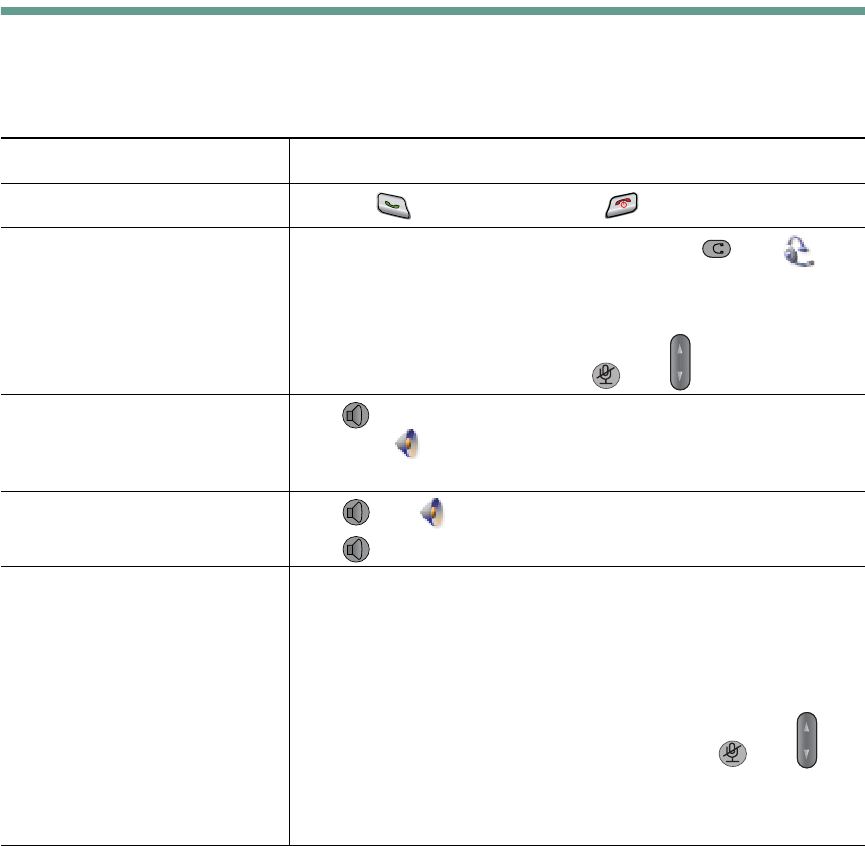
Using a Handset, Headset, and Speakerphone
Cisco Unified Wireless IP Phone 7921G for Cisco Unified CallManager 4.1, 4.2, 5.0 and Later 43
FINAL REVIEW - Cisco Confidential
Using a Handset, Headset, and Speakerphone
You can use your phone as a mobile handset, a speakerphone, with a headset, or with the
speakerphone in the desk top charger.
If you want to... Then...
Use the handset Press the (green button); press (red button) to hang up.
Use a headset Plug the headset connector into the headset port . The icon
displays on the phone status line. Place and answer calls as usual.
If you use AutoAnswer, see Using AutoAnswer, page 44 for
exceptions.
You can use the headset with all the
controls on your phone, including and .
Use the speaker mode Press before placing a call or during a call to activate speaker
mode. The icon displays when the speaker is active.
Note Speaker mode remains active for future calls until toggled off.
Switch to the speaker (from the
handset) during a call
Press and displays.
Press to toggle back to the handset.
Switch to the desk top charger
speakerphone
1. Place the wireless IP phone in the desk top charger cradle.
“AC connected!” displays on the screen.
2. Press down on the top of the phone.
“Docking connected!” displays on the screen and the desk top
charger speaker and microphone are now connected.
3. Place and receive calls.
Use all the buttons on your phone, including and .
Note The internal single-direction microphone is located on the
lower left side of the phone (two small holes). For best results,
face the desk top charger when using the speakerphone.
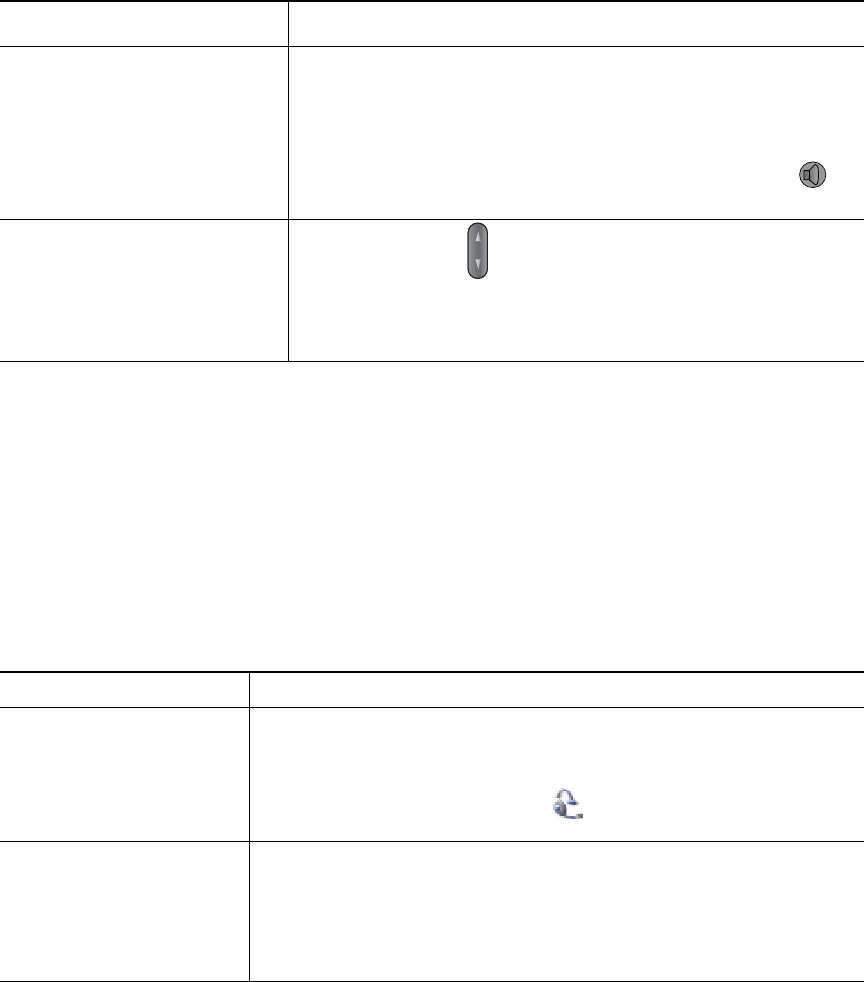
44 OL-10806-01
FINAL REVIEW - Cisco Confidential
Obtaining a Headset
Your phone supports headset jack types with a 2.5 mm 3-band/ 4 connector. For information about
purchasing headsets, see Headset Information, page 12.
Using AutoAnswer
You might use AutoAnswer if you receive a high volume of incoming calls or handle calls on behalf of
others. Your system administrator configures AutoAnswer to work with either your speaker mode or
headset.
Switch to the handset from the
desk top charger speakerphone
1. Tip the top of the phone forward about 30 degrees, then pick
up the phone.
2. The desk top charger speaker and microphone disconnect and
the call is now active on the phone.
Note You cannot turn off the desk top speaker by using the
button.
Adjust the volume level for a
call
During a call, press to adjust the volume for the handset,
speaker, or headset
depending on which mode is in use.
Note The new volume level is preserved for future calls after
powering off the phone.
If you... Then...
Use AutoAnswer with a
headset
Keep headset mode active by ensuring the headset is plugged into the
phone, even when not on a call.
If your phone is set up to use AutoAnswer in headset mode, calls are
answered automatically only if the icon is in the phone status line.
Otherwise, calls ring normally and you must manually answer them.
Use AutoAnswer with the
desktop charger speaker
Keep the handset in the desktop charger cradle so the speaker is active.
If your phone is set up to use AutoAnswer in speaker mode, calls are
answered automatically using the desktop charger speaker.
Note You cannot turn off the desktop charger speaker. You must remove
the phone from the cradle to disable the desktop charger speaker.
If you want to... Then...
Using a Handset, Headset, and Speakerphone
Cisco Unified Wireless IP Phone 7921G for Cisco Unified CallManager 4.1, 4.2, 5.0 and Later 45
FINAL REVIEW - Cisco Confidential
Tip
While your Cisco Unified Wireless IP Phone 7921G is in the desktop charging cradle, you can use the
headset to answer calls. The headset audio is always active when the headset is connected to the phone.
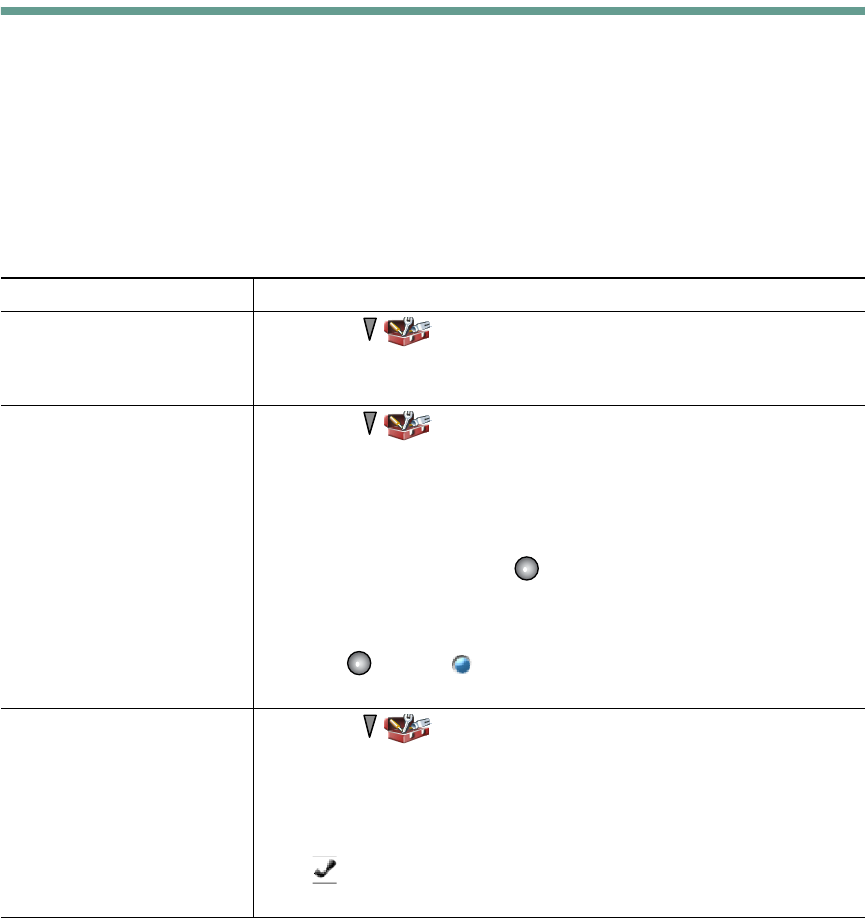
Using Phone Settings
Cisco Unified Wireless IP Phone 7921G for Cisco Unified CallManager 4.1, 4.2, 5.0 and Later 45
FINAL REVIEW - Cisco Confidential
Using Phone Settings
You can personalize your Cisco Unified Wireless IP Phone 7921G by adjusting sound settings, volume
levels, display options, and keypad settings. You can also view your Network Profiles from the Settings
menu.
Customizing Rings
You can customize your phone by choosing a ring type for each line.
If you want to... Then...
View the ring tone settings
on your lines
1. Choose (Settings) > Phone Settings > Sound Settings.
2. Select Ring Tone > Current Settings.
3. Press View to see the current line settings.
Change the ring tone on a
line
1. Choose (Settings) > Phone Settings > Sound Settings.
2. Select Ring Tone > Current Settings.
3. Press View to see the current line settings.
4. Select a line.
Note You can make a selection by pressing the number key for the item,
the Change softkey, or .
5. Scroll to a ring tone in the list and press Play to hear a sample of
the ring.
6. Press and the icon appears next to the chosen ring.
7. Choose Options > Save to make the change or Options > Cancel.
Assign a ring tone to a line 1. Choose (Settings) > Phone Settings > Sound Settings.
2. Select Ring Tone > Available Ring Tones.
3. Scroll to a ring tone in the list and press Play to hear a sample of
the ring.
4. Choose Options > Apply and select the line for the ring tone.
A displays by the selected line.
5. Press Save to make the change or Cancel.

46 OL-10806-01
FINAL REVIEW - Cisco Confidential
Tips
•You cannot modify the Ring Settings for the wireless IP phone from the User Options web pages.
•To return to the Settings menu, press Back after saving the change or press to return to the
main screen.
Customizing Volume Settings
You can adjust the ring and speaker volume settings for your phone.
Change the way your phone
rings
1. Choose (Settings) > Sound Settings > Alert Pattern.
2. Select one of the following:
•Ring Only
•Vibrate Only
•Silent
•Vibrate, Then Ring
•Vibrate And Ring
The appears next to your selection.
3. Press Save to make the change or Cancel.
If you want to... Then...
Adjust the ring volume level 1. Choose (Settings) > Phone Settings > Sound Settings >
Volumes.
2. Select Ring.
Note You can make a selection by pressing the number key for the item,
the Change softkey, or .
3. Press to increase the volume or to decrease the volume and
hear a sample ring volume.
4. Press Save to make the change or Cancel.
Adjust the speaker volume
level
1. Choose (Settings) > Phone Settings > Sound Settings>
Volumes.
2. Select Speaker.
3. Press to increase the volume or to decrease the volume.
4. Press Save to make the change or Cancel.
If you want to... Then...
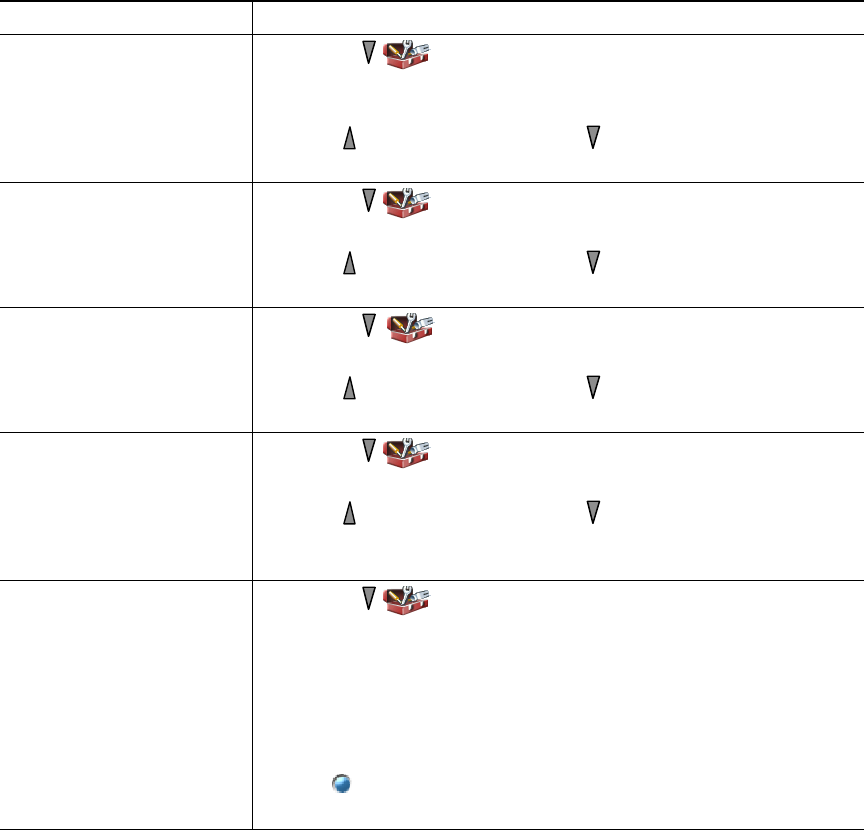
Using Phone Settings
Cisco Unified Wireless IP Phone 7921G for Cisco Unified CallManager 4.1, 4.2, 5.0 and Later 47
FINAL REVIEW - Cisco Confidential
Adjust the phone volume
level
1. Choose (Settings) > Phone Settings > Sound Settings >
Volumes.
2. Select Handset.
3. Press to increase the volume or to decrease the volume.
4. Press Save to make the change or Cancel.
Adjust the headset volume
level
1. Choose (Settings) > Phone Settings > Sound Settings.
2. Select Headset.
3. Press to increase the volume or to decrease the volume.
4. Press Save to make the change or Cancel.
Adjust the desktop charger
speaker volume level
1. Choose (Settings) > Phone Settings > Sound Settings
2. Select Docking Speaker.
3. Press to increase the volume or to decrease the volume.
4. Press Save to make the change or Cancel.
Adjust the desktop charger
ring volume level
1. Choose (Settings) > Phone Settings > Sound Settings.
2. Select Docking Ring.
3. Press to increase the volume or to decrease the volume and
hear a sample ring volume.
4. Press Save to make the change or Cancel.
Select the devices that will
ring
1. Choose (Settings) > Phone Settings > Sound Settings.
2. Select Ring Output.
3. Select one of the following:
•Headset
•Speaker (default setting)
•Headset and Speaker
The appears next to your selection.
4. Press Save to make the change or Cancel.
If you want to... Then...
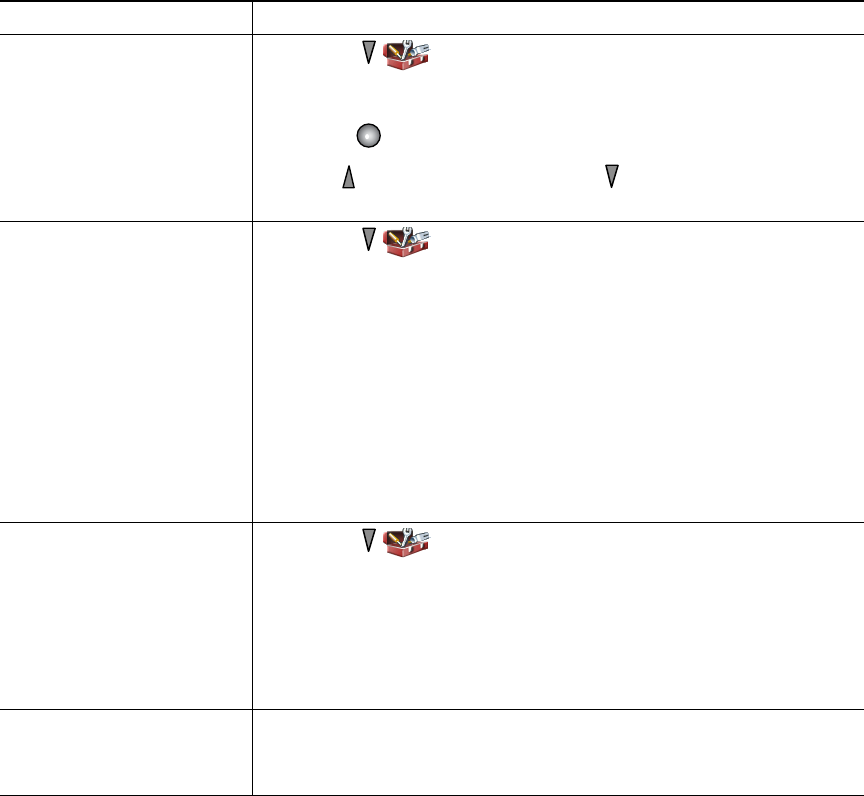
48 OL-10806-01
FINAL REVIEW - Cisco Confidential
Customizing the Phone Screen
You can adjust the length of time that your phone screen displays and its brightness.
Changing Keypad Settings
You can set the keypad to automatically lock, to make tones and to answer a call. See these sections
for more information:
If you want to... Then...
Change the phone display
brightness
1. Choose (Settings) > Phone Settings > Display Settings.
2. Select Display Brightness.
Note You can make a selection by pressing the number key for the item,
the button, or the Change softkey.
3. Press to increase the brightness or to decrease the brightness.
4. Press Save to make the change or Cancel.
Change the length of time
for the screen to display
1. Choose (Settings) > Phone Settings > Display Settings.
2. Select Display Timeout.
3. Select one of the following:
•10 seconds
•30 second (default setting)
•1 minute
•2 minutes
4. Press Save to make the change or Cancel.
Note When the display setting time has expired, the screen dims for 10
seconds, then goes dark.
Change the LED indication
for service coverage
1. Choose (Settings) > Phone Settings > Display Settings.
2. Select LED Coverage Indicator.
3. Select one of the following:
•Enable (default setting)
•Disable
4. Press Save to make the change or Cancel.
Change the language on
your phone screen
1. Log in to your User Options web pages. (See Accessing Your
User Options Web Pages, page 59.
2. Change the language setting.

Using Phone Settings
Cisco Unified Wireless IP Phone 7921G for Cisco Unified CallManager 4.1, 4.2, 5.0 and Later 49
FINAL REVIEW - Cisco Confidential
•Using Any Key to Answer the Phone, page 49
•Setting the Keypad to Automatically Lock, page 49
•Changing the Keypad Tones, page 50
Using Any Key to Answer the Phone
You can set your phone to allow the use of any key to answer a call.
Setting the Keypad to Automatically Lock
To keep from pressing keys and redialing calls accidentally, use the keypad auto lock feature. You can
set the length of time before your phone keypad automatically locks after completing a call.
If you want to... Then...
Answer calls by pressing any
key
1. Choose (Settings) > Phone Settings > Keypad Settings.
2. Select Any Key Answer.
3. Select Enable.
4. Press Save to make the change or Cancel.
Note Under the Any Key Answer option, Enabled displays.
Disable the Any Key Answer
option
1. Choose (Settings) > Phone Settings > Keypad Settings.
2. Select Any Key Answer.
3. Select Disable.
4. Press Save to make the change or Cancel.
Note Under the Any Key Answer option, Disabled displays.
If you want to... Then...
Automatically lock the keypad
after using the phone
1. Choose (Settings) > Phone Settings > Keypad Settings.
2. Select Keypad Auto Lock.
3. Select one of these time intervals:
•15 seconds
•30 seconds
•60 seconds
4. Press Save to make the change or Cancel.
Note After the chosen time interval expires, the icon displays
and the keypad is locked.
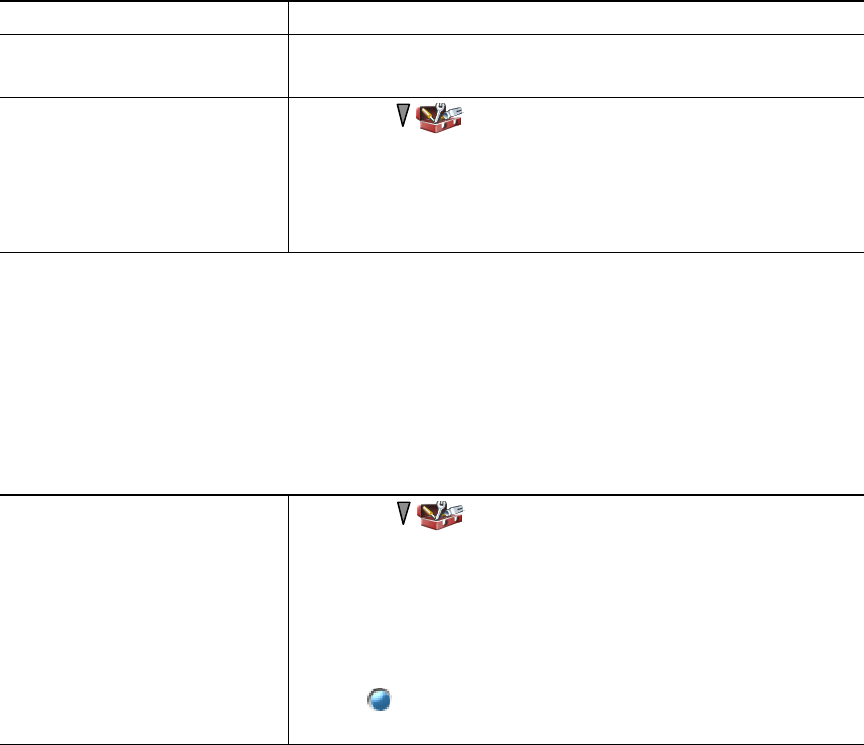
50 OL-10806-01
FINAL REVIEW - Cisco Confidential
Tips
•Auto lock is enabled only when the phone is idle and at the main screen.
•The keypad lock is temporarily disabled when you have an incoming call.
Changing the Keypad Tones
You can enable or disable the tones when you press a key on your keypad.
Viewing Your Network Profile List
Network profiles provide predefined settings for access to the wireless network and for authentication
and encryption in your system. Your phone administrator defines network profiles. You might have
more than one network profile available to you so you can access wireless network configurations at
locations that use different SSIDs or authentication types.
Your Cisco Unified Wireless IP Phone 7921G can have up to four enabled network profiles. Your
phone automatically scans the profiles and selects the network profile with the matching SSID and
settings for that specific wireless network.
Unlock the keypad 1. Press any key and the screen displays “Unlock keypad?”
2. Press Yes to unlock the keypad or No to keep the lock.
Turn off the automatic keypad
lock
1. Choose (Settings) > Phone Settings > Keypad Settings.
2. Select Keypad Auto Lock.
3. Select Disable.
4. Press Save to make the change or Cancel.
Note Under the Keypad Auto Lock option, Disabled displays.
Change the keypad tone level 1. Choose (Settings) > Phone Settings > Keypad Settings.
2. Select Keypad Tone.
3. Select one of the following:
•Disable—Plays no keypad tone.
•Normal—Plays tone when pressing keys.
•Loud—Plays louder tone when pressing keys.
The icon appears next to your selection.
4. Press Save to make the change or Cancel.
If you want to... Then...
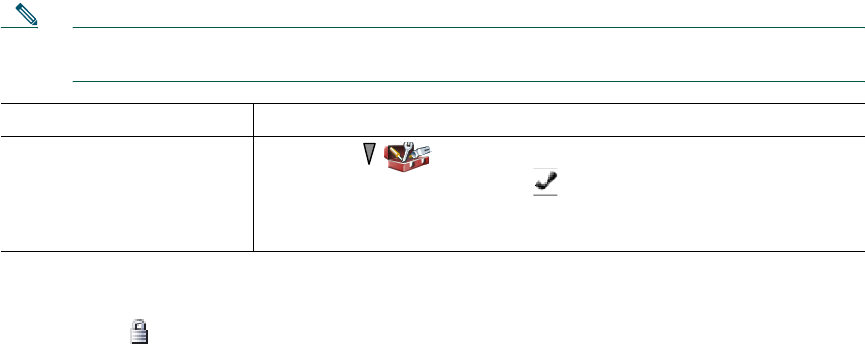
Using Phone Settings
Cisco Unified Wireless IP Phone 7921G for Cisco Unified CallManager 4.1, 4.2, 5.0 and Later 51
FINAL REVIEW - Cisco Confidential
Note Consult with your phone administrator if you need to have additional network profiles or
change settings in a profile.
Tips
•When the locked icon appears next to a menu, see your phone administrator for information.
•If you need to change your EAP or LEAP username and password, see Setting Username and
Passwords, page 11 and consult with your phone administrator.
If you want to... Then...
View the list of enabled
Network Profiles
1. Choose (Settings) > Network Profiles.
2. The enabled profiles have a next to them
Note Network profiles are locked. Your phone administrator must make
changes for you.
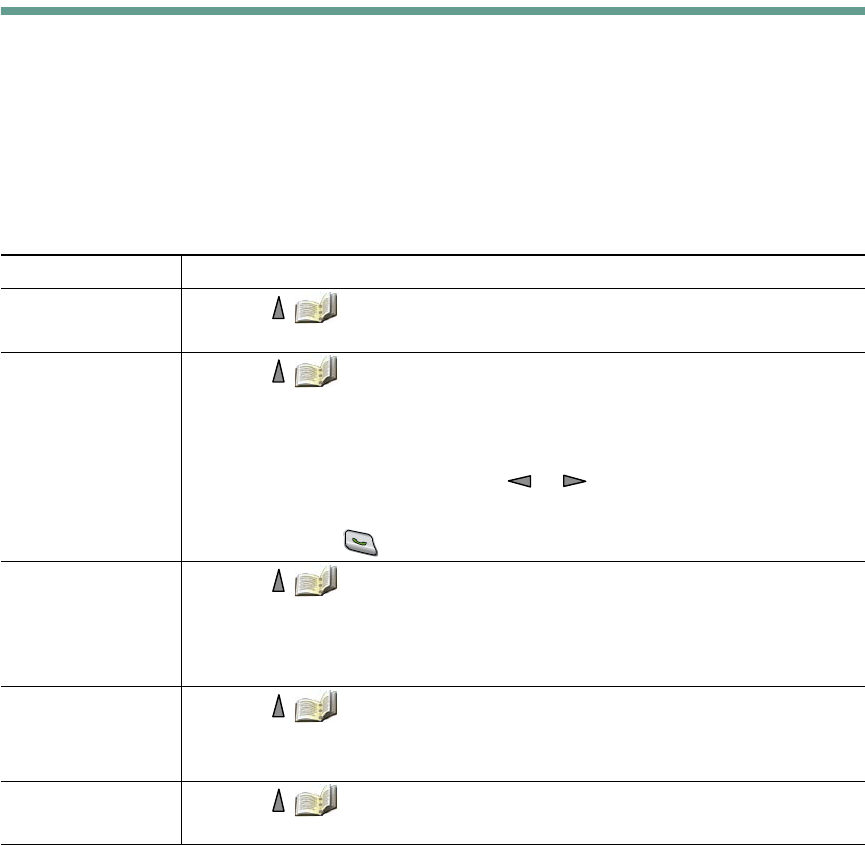
Using Call Logs and Directories
Cisco Unified Wireless IP Phone 7921G for Cisco Unified CallManager 4.1, 4.2, 5.0 and Later 51
FINAL REVIEW - Cisco Confidential
Using Call Logs and Directories
This section describes how you can use call logs and directories in the Directory menu.
Using Call Logs
Your phone maintains records of your missed, placed, and received calls.Each call log holds up to 30
entries.
If you want to... Then...
View your call logs 1. Press (Directory).
2. Choose Missed Calls, or Received Calls, or Placed Calls.
Dial from a call log 1. Press (Directory).
2. Choose Missed Calls, or Received Calls, or Placed Calls.
3. Scroll to a phone number.
Note To edit the displayed number (to add or to remove a prefix), press
Options > EditDial followed by or to reposition the cursor. Use the
keypad to enter digits, or press << to delete numbers.
4. Press Dial or .
Delete a call record 1. Press (Directory).
2. Choose Missed Calls, or Received Calls, or Placed Calls.
3. Scroll to a call record.
4. Choose Options > Delete. Or choose Options > Exit.
Delete a call log 1. Press (Directory).
2. Choose Missed Calls, or Received Calls, or Placed Calls.
3. Choose Options > Delete. Or choose Options > Exit.
Erase your call logs 1. Press (Directory) to display call logs.
2. Press Clear. Doing so erases all call logs. Or choose Options > Exit.

52 OL-10806-01
FINAL REVIEW - Cisco Confidential
Directory Dialing
Depending on configuration, your phone can provide access to a corporate directory and personal
directory features:
•Corporate Directory—Corporate contacts that you can access on your phone. Corporate
Directory is set up and maintained by your phone administrator.
•Personal Directory—If available, personal contacts and associated speed-dial codes that you can
configure and access from your phone and User Options web pages. Personal Directory is
comprised of Personal Address Book (PAB) and Fast Dials.
–
PAB is a directory of your personal contacts.
–
Fast Dial allows you to assign codes to PAB entries for quick dialing.
Using Corporate Directory on Your Phone
You can use a corporate directory to place calls to coworkers.
Tips
•Use the numbers on your keypad to enter characters on your phone screen. See Entering and
Editing Text, page 11.
•Use the Navigation button on your phone to move between input fields.
Using Personal Directory on Your Phone
The Personal Directory feature set contains your Personal Address Book (PAB) and Fast Dials.
If you want to... Then...
Dial from a corporate
directory (while not
on another call)
1. Choose (Directory) > Directory Services > Corporate Directory
(name can vary).
2. Use your keypad to enter a search criteria such as a name.
3. Choose or Options > Submit.
4. Scroll to a listing.
Note To edit the displayed number (to add or to remove a prefix), choose
Options > EditDial followed by or to reposition the cursor. Use
the keypad to enter digits, or press << to delete numbers.
5. Press Dial or .
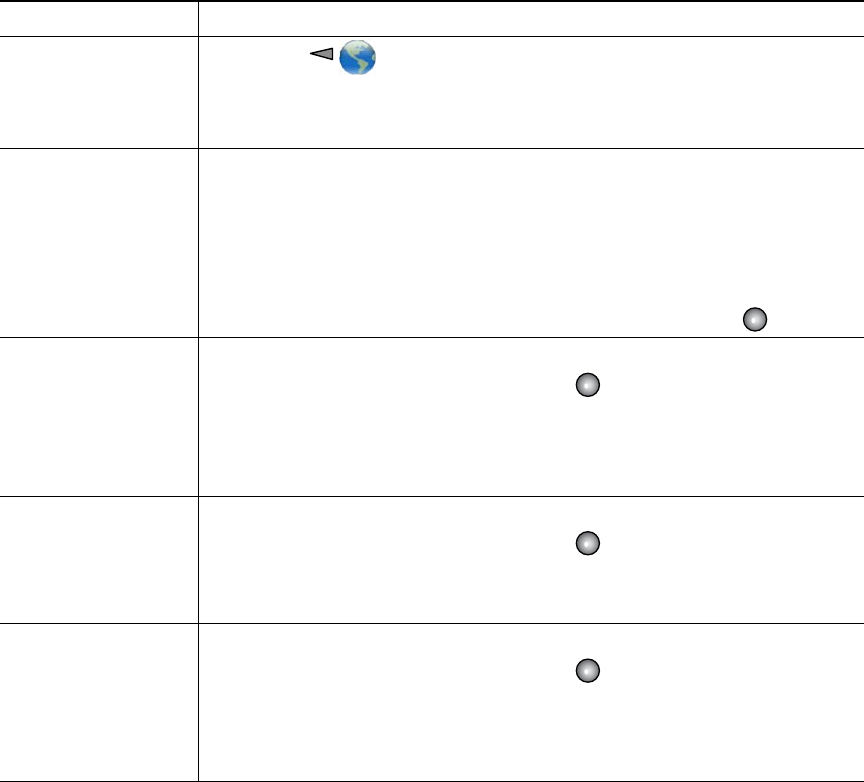
Using Call Logs and Directories
Cisco Unified Wireless IP Phone 7921G for Cisco Unified CallManager 4.1, 4.2, 5.0 and Later 53
FINAL REVIEW - Cisco Confidential
Cisco Unified CallManager Release 4.0 and Later
For information about how to set up and use the Personal Directory when connected to a Cisco Unified
CallManager 4.1 or later system, refer to Customizing Your Cisco IP Phone on the Web:
http://www.cisco.com/univercd/cc/td/doc/product/voice/c_ipphon/index.htm
Cisco Unified CallManager Release 5.0 and Later
This section describes how to set up and use Personal Directory on your phone when you are connected
to a Cisco Unified CallManager 5.0 or later. Alternately, see Using Personal Directory on the Web,
page 61.
If you want to... Then...
Access Personal
Directory (for PAB
and Fast Dial codes)
1. Choose (Services) > Personal Address Book (PAB) Service (exact
name may vary).
2. Enter your Cisco Unified CallManager user ID and PIN, then press
Options > Submit.
Search for a PAB
entry
1. Access Personal Address Book.
2. Enter search criteria and choose Options > Submit.
Note To get a complete list of your PAB entries, do not enter any search criteria,
and choose Options > Submit.
3. You can choose Options > Previous or Next to move through listings.
4. Scroll to the PAB listing that you want and press Select or .
Dial from PAB entry 1. Search for a PAB entry.
2. Scroll to the listing and press Select or .
3. Press Dial.
4. Scroll to the number that you want to dial and press OK.
5. Press OK again to dial the number.
Delete a PAB entry 1. Search for a PAB entry.
2. Scroll to the listing and press Select or .
3. Choose Options >Delete.
4. Press OK to confirm the deletion or Cancel.
Edit a PAB entry 1. Search for a PAB entry.
2. Scroll to the listing and press Select or .
3. Choose Options > Edit to modify a name or mail address.
4. If necessary, choose Options > Phones to modify a phone number.
5. Press Update.
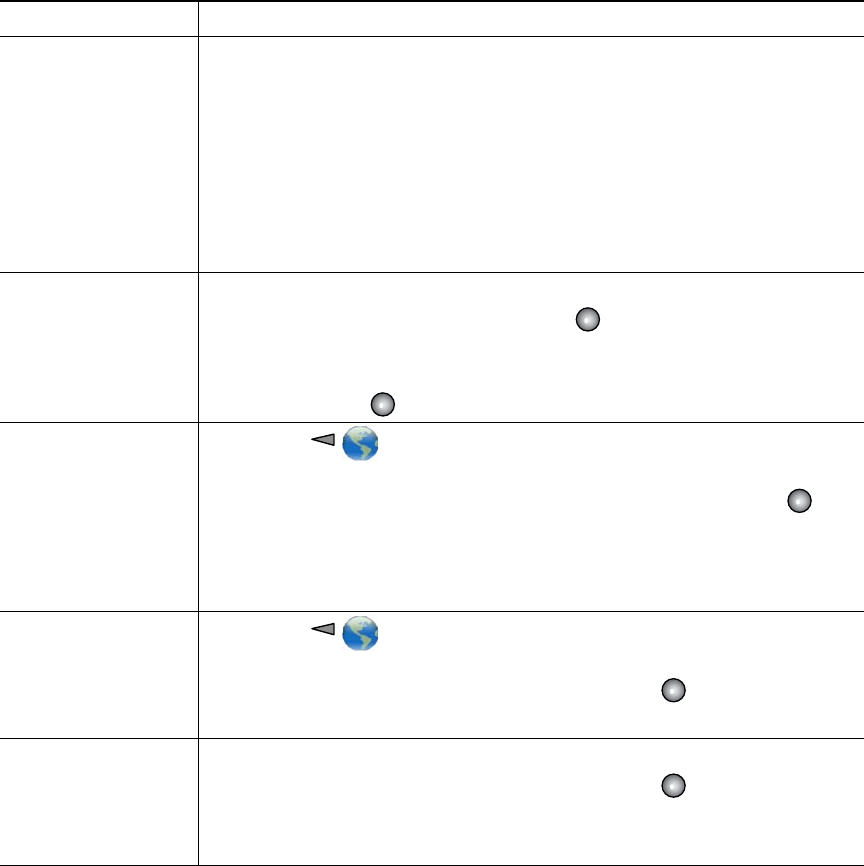
54 OL-10806-01
FINAL REVIEW - Cisco Confidential
Add a new PAB entry 1. Access Personal Address Book.
2. Access the Search page and choose Options > Submit. (you do not need
to input search information first.)
3. Choose Options > New.
4. Use the keypad to enter a name or nickname.
5. Press Phones and use the keypad to enter phone numbers. Be sure to
include any necessary access codes such as a 9 or 1.
6. Press Submit to add the entry to the database.
Assign a Fast Dial
code to a PAB entry
1. Search for a PAB entry.
2. Scroll to the listing and press Select or .
3. Choose Options > Fast Dial.
4. Scroll to the Fast Dial code that you want to assign to the number and
press Select or .
Add a new Fast Dial
code (not using a PAB
entry)
1. Choose (Services)> Personal Address Book
2. Select Personal Fast Dials.
3. Scroll to a Fast Dial code that is unassigned and press Select or .
4. Press Assign.
5. Enter a phone number.
6. Press Update.
Search for Fast Dial
codes
1. Choose (Services) > Personal Address Book.
2. Select Personal Fast Dials.
3. Scroll to the listing you want and press Select or .
Note You can choose Options > Previous or Next to move through listings.
Place a call using a
Fast Dial code
1. Search for a Fast Dial code.
2. Scroll to the listing you want and press Select or .
3. Press Dial.
4. Choose OK to complete the action.
If you want to... Then...

Using Call Logs and Directories
Cisco Unified Wireless IP Phone 7921G for Cisco Unified CallManager 4.1, 4.2, 5.0 and Later 55
FINAL REVIEW - Cisco Confidential
Tips
•Your phone administrator can provide the user ID and PIN that you need to log in to Personal
Directory.
•Personal Directory automatically logs you out after a certain amount of time. This time limit can
vary. Ask your phone administrator for more information.
•Use the numbers on your keypad to enter characters on your phone screen. Use the Navigation
button on your phone to move between input fields.
Delete a Fast Dial
code
1. Search for a Fast Dial code.
2. Scroll to the listing you want and press Select or .
3. Choose Options > Remove.
Log out of Personal
Directory
1. Choose (Services) > Personal Address Book (exact name may
vary).
2. Choose Logout.
If you want to... Then...
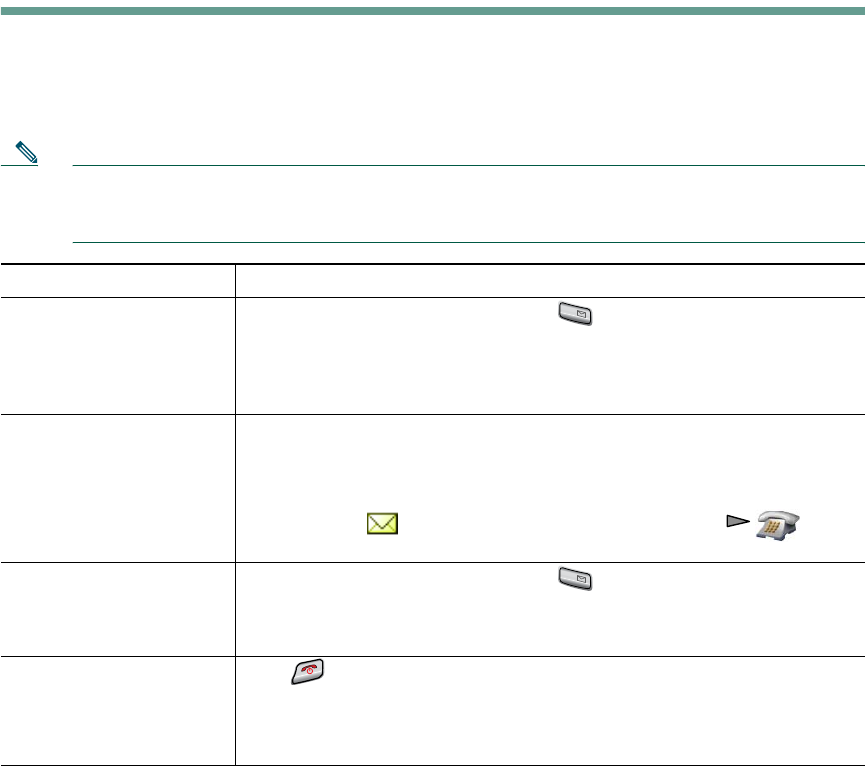
56 OL-10806-01
FINAL REVIEW - Cisco Confidential
Accessing Voice Messages
When the phone displays, “You Have VoiceMail” or a red blinking light, you can access your messages
from your phone.
Note Your company determines the voice message service that your phone system uses. For the most
accurate and detailed information, refer to the documentation that came with your voice
messaging service.
If you want to... Then...
Set up and personalize
your voice message
service
1. Press Message or press and hold .
2. Follow the voice instructions.
Your phone administrator will provide a default password for your
voice messaging service.
See if you have a new
voice message
Look at your phone for these indicators:
•A red blinking message waiting light.
•A text message, “You Have VoiceMail”
•A flashing icon next to your directory number in (Line
View)
Listen to your voice
messages or access the
voice messages menu
1. Press Message or press and hold .
2. Enter your voice messaging password.
3. Follow the voice instructions to listen to your messages.
Send a call to your voice
message system
Press (red button) or iDivert.
The iDivert feature automatically transfers a call (including a ringing or
held call) to your voice message system. Callers will hear your voice
message greeting and can leave you a message.
1
@
1
@

Accessing Your User Options Web Pages
Cisco Unified Wireless IP Phone 7921G for Cisco Unified CallManager 4.1, 4.2, 5.0 and Later 57
FINAL REVIEW - Cisco Confidential
Accessing Your User Options Web Pages
Your Cisco Unified Wireless IP Phone 7921G is a network device that can share information with
other network devices in your company, including your personal computer. You can use your computer
to log in to your Cisco Unified CallManager User Options web pages, where you can control features,
settings, and services for your wireless IP phone. For example, you can set up speed-dial keys from
your User Options web pages.
Cisco Unified CallManager Release 4.1 and Later
User Options Web Pages
This section describes how to access your User Options web pages and how to subscribe to phone
services when you are connected to a Cisco Unified CallManager 4.1 or later system. For more details
about the features you can configure and the phone services to which you can subscribe, refer to
Customizing Your Cisco Unified IP Phone on the Web at the following URL:
http://www.cisco.com/univercd/cc/td/doc/product/voice/c_ipphon/index.htm
Logging In to the User Options Web Pages
This section describes how to log in and select a phone device for Cisco Unified CallManager Release
4.1 or later User Options web pages.
Tips for Navigating the User Options Web Pages
•Select your device from the menu page to see all of your options.
•Click Update to apply and save your changes.
If you want to... Then do this...
Log in to your User
Options web pages
1. Obtain a User Options URL, user ID, and default password from your
phone administrator.
2. Open a web browser on your computer, enter the URL, and log on.
The Cisco Unified CallManager User Options main web page displays.
Select a device after
logging in
1. From the general menu, select your device type (phone model) in the “Select
a device” drop-down list.
The context-sensitive menu appears with options appropriate for the
wireless IP phone.
2. Make changes to the options for your wireless IP phone.

58 OL-10806-01
FINAL REVIEW - Cisco Confidential
•Click Return to the Menu to get back to the context-sensitive menu.
•Click Log Off to exit the User pages.
Subscribing to Phone Services
Before you can access subscription phone services on your phone, you need to subscribe to them by
using your computer to access the User Options web pages. See Accessing Your User Options
Web Pages, page 59.
Phone services can include:
•Web-based information, such as stock quotes, movie listings, and weather reports
•Network data, such as corporate calendars and searchable directories
•Phone features, such as the Fast Dial service and a Personal Address Book
Refer to the following table for more information.
If you want to... Then do this after you log in and select your device type...
Subscribe to a service 1. From the main menu, choose Configure your Cisco IP Phone Services.
2. Select a service from the “Available Services” drop-down list and click
Continue.
3. Enter more information upon request (such as a zip code or PIN).
4. Click Subscribe.
Change or end
subscriptions
1. From the main menu, choose Configure your Cisco IP Phone Services.
2. Click a service in the “Your Subscribed Services” panel.
3. Click Update after making changes, or click Unsubscribe.
Access a service on
your phone
1. Choose (Services) > (Service Name).
2. Select the service that you want.
Learn how to use
phone services
Refer to Customizing Your Cisco IP Phone on the Web:
http://www.cisco.com/univercd/cc/td/doc/product/voice/c_ipphon/index.htm

Accessing Your User Options Web Pages
Cisco Unified Wireless IP Phone 7921G for Cisco Unified CallManager 4.1, 4.2, 5.0 and Later 59
FINAL REVIEW - Cisco Confidential
Cisco Unified CallManager Release 5.0 and Later
User Options Web Pages
This section describes how to access your User Options web pages and how to subscribe to phone
services when you are connected to a Cisco Unified CallManager 5.0 or later system. Use these sections
for more details about accessing the User Options web pages and configuring features and subscribing
to phone services:
•Accessing Your User Options Web Pages, page 59
•Configuring Features and Services on the Web, page 60
Accessing Your User Options Web Pages
This section describes how to log in and select a phone device for Cisco Unified CallManager Release
5.0 or later User Options web pages.
If you want to... Then do this...
Log in to your User
Options web pages
1. Obtain a User Options URL, user ID, and default password from
your phone administrator.
2. Open a web browser on your computer, enter the URL, and log on.
3. If prompted to accept security settings, click Yes or Install
Certificate.
The Cisco Unified CallManager User Options main web page
displays. From this page you can choose User Options to access User
Settings, Directory features, a Personal Address Book, and Fast
Dials.
Or, to access phone-specific options, select a device (see below).
Select a device after
logging in
1. After you have logged in to your User Options web pages, choose
User Options > Device.
The Device Configuration page displays.
2. If you have multiple devices assigned to you, verify that the
appropriate device (phone model or Extension Mobility profile) is
selected. If necessary, choose another device from the Name
drop-down menu.
Configure user features Choose User Options drop-down button to access these features:
•User Settings
•Directory
•Personal Address Book
•Fast Dials

60 OL-10806-01
FINAL REVIEW - Cisco Confidential
Tip
Use the Device Configuration page to access all of the configuration options available for your phone
(other pages might not provide access to all options).
Configuring Features and Services on the Web
These topics describe how to configure features and services from your User Options web pages after
logging in. See Accessing Your User Options Web Pages, page 59.
•Setting Up Speed Dials on the Web, page 60
•Using Personal Directory on the Web, page 61
•Setting Up Phone Services on the Web, page 64
•Controlling User Settings on the Web, page 65
•Controlling Line Settings on the Web, page 66
•Using Cisco WebDialer, page 68
Setting Up Speed Dials on the Web
Depending on configuration, your phone can support several speed-dial features:
•Speed-dial Numbers
•Abbreviated Dialing
•Fast Dials
Configure phone settings Choose toolbar buttons to access these phone-specific options:
•line settings
•speed dials
•phone services
•service URL
Return to the Device
Configuration page
Choose User Options > Device from any page to verify that you are
configuring the correct device or to change devices.
If you want to... Then do this...
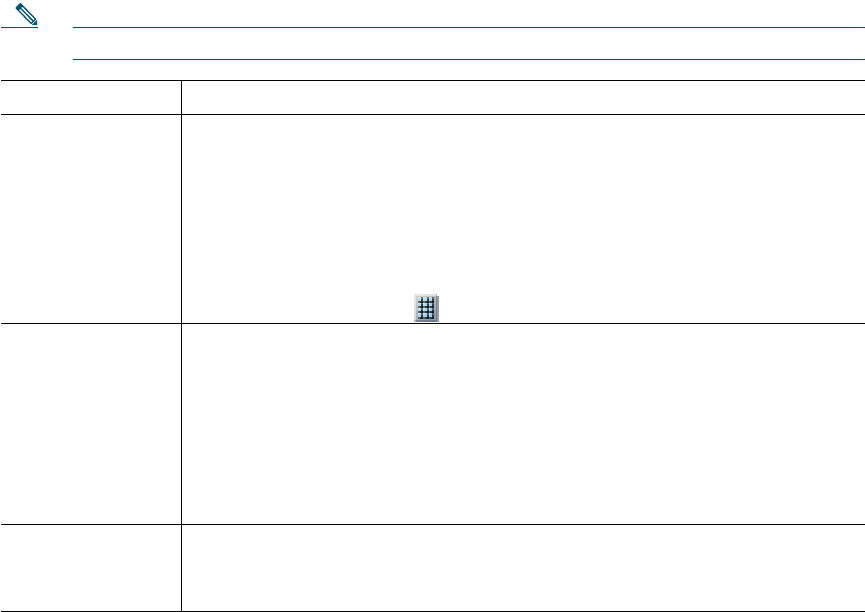
Accessing Your User Options Web Pages
Cisco Unified Wireless IP Phone 7921G for Cisco Unified CallManager 4.1, 4.2, 5.0 and Later 61
FINAL REVIEW - Cisco Confidential
Note For help using speed-dial features, see Speed Dialing, page 35.
Tips
•You can have up to six numbers appear in your Line View screen (a combination of line and speed
dial numbers).
•If your speed dial label is more than 11 characters, the label is shortened with following periods
(customer service appears as customer s....).
Using Personal Directory on the Web
The Personal Directory feature set that you can access on your computer consists of:
•A Personal Address Book (PAB)
•Fast Dials
•The Address Book Synchronization Tool (TABSynch)
If you want to... Then do this after you log in...
Set up Line View
speed-dial numbers
1. Select the name for the Cisco 7921 device.
2. Click Speed Dials.
3. Enter a phone number as you would dial it.
4. Enter a label for the speed-dial number that is 11 characters or less.
5. Click Save
Note If you have speed dials configured in your Line View, the speed-dial label
appears next to the icon.
Set up Abbreviated
Dialing
1. Select the name for the Cisco 7921 device.
2. Click Speed Dials.
3. Enter a phone number as you would dial it and label for an Abbreviated
Dialing code.
4. Click Save.
Note Make note of the number for the Abbreviated Dialing Code. Use this code
with Options > AbbrDial to access the speed-dial number.
Set up Fast Dials See Configuring Fast Dials on the Web, page 63.
You can also set up Fast Dials on your phone. See the Using Personal Directory
on Your Phone, page 52.

62 OL-10806-01
FINAL REVIEW - Cisco Confidential
Note You can also access PAB and Fast Dials from your phone. See Using Personal Directory on
Your Phone, page 52.
Using Your Personal Address Book on the Web
This section describes how to use your PAB from your User Options web pages.
If you want to... Then do this after you log in...
Add a new PAB entry 1. Choose User Options > Personal Address Book.
2. Click Add New.
3. Enter information for the entry.
4. Click Save.
Search for a PAB entry 1. Choose User Options > Personal Address Book.
2. Specify search information and click Find.
Note To locate all entries, leave search information blank and click Find.
Edit a PAB entry 1. Search for a PAB entry.
2. Click a name or nickname.
3. Edit the entry as needed and click Save.
Delete a PAB entry 1. Search for a PAB entry.
2. Select one or more entries.
3. Click Delete Selected.

Accessing Your User Options Web Pages
Cisco Unified Wireless IP Phone 7921G for Cisco Unified CallManager 4.1, 4.2, 5.0 and Later 63
FINAL REVIEW - Cisco Confidential
Configuring Fast Dials on the Web
This section describes how to assign Fast Dials from your User Options web pages.
Tips
•You can create up to 500 Fast Dial and PAB entries.
•You can create a new Fast Dial entry without using a PAB entry. Such Fast Dial entries are labeled
“raw” in the User Options web pages and do not display a configurable text label.
If you want to... Then do this after you log in...
Assign a Fast Dial code
to a PAB entry
1. Create a PAB entry. See Using Your Personal Address Book on the
Web, page 62.
2. Choose User Options > Fast Dials.
3. Click Add New.
4. Change the Fast Dial code, if desired.
5. Use the Search Options area to find the appropriate PAB entry.
6. Click a phone number in the Search Results area.
7. Click Save.
Assign a Fast Dial code
to a phone number
(without using a PAB
entry)
1. Choose User Options > Fast Dials.
2. Click Add New.
3. Change the Fast Dial code, if desired.
4. Enter a phone number.
5. Click Save.
Search for a Fast Dial
entry
1. Choose User Options > Fast Dials.
2. Specify search information and click Find.
Edit a Fast Dial phone
number
1. Choose User Options > Fast Dials.
2. Search for the Fast Dial entry that you want to edit.
3. Click on a component of the entry.
4. Change the phone number.
5. Click Save.
Delete a Fast Dial entry 1. Search for a Fast Dial.
2. Select one or more entries.
3. Click Delete Selected.

64 OL-10806-01
FINAL REVIEW - Cisco Confidential
Using the Address Book Synchronization Tool
You can use the Address Book Synchronization tool (TABSynch) to synchronize your existing
Microsoft Windows Address Book (if applicable) with your PAB. Entries from your Microsoft
Windows Address Book will then be accessible on your wireless IP phone and User Options web pages.
Your phone administrator can give you access to TABSynch and provide detailed instructions.
Setting Up Phone Services on the Web
Phone services can include special phone features, network data, and web-based information (such as
stock quotes and movie listings). You must first subscribe to a phone service before accessing it on your
phone.
If you want to... Then do this after you log in...
Subscribe to a service 1. Select a device.
2. Click Phone Services.
3. Click Add New.
4. Choose a service from the drop-down list and click Next.
5. Change the service label and/or enter additional service information, if
available (optional).
6. Click Save.
Search for services 1. Select a device.
2. Click Phone Services.
3. Click Find.
Change or end services 1. Search for services.
2. Select one or more entries.
3. Click Delete Selected.
Change a service name 1. Search for services.
2. Click on the service name.
3. Change the information and click Save.

Accessing Your User Options Web Pages
Cisco Unified Wireless IP Phone 7921G for Cisco Unified CallManager 4.1, 4.2, 5.0 and Later 65
FINAL REVIEW - Cisco Confidential
Controlling User Settings on the Web
User settings include your password, PIN, and language (locale) settings. Your PIN and password
allow you to access different features and services.
Add a service to an
available screen slot
1. Select a device.
2. Click Service URL.
Note If you do not see this option, ask your phone administrator to configure
a service URL button for your phone.
3. Choose a service from the Button Service drop-down list.
4. If you want to rename the service, edit the label fields.
Note Your phone uses the ASCII Label field if the phone does not support
double-byte character sets.
5. Click Save.
6. Click Reset to reset your phone (necessary to see the new label on your
phone).
Access a service on your
phone
Choose (Services) > (Service Name).
If you want to... Then do this after you log in...
Change your password 1. Choose User Options > User Settings.
2. In the Browser Password area, enter information.
Note A password must be 5-127 characters.
3. Click Save.
Change your PIN 1. Choose User Options > User Settings.
2. In the Phone PIN area, enter information.
Note A PIN must be 5-20 numbers.
3. Click Save.
Change the language (locale) for
your User Options web pages
1. Choose User Options > User Settings.
2. In the User Locale area, choose an item from the Locale
drop-down list.
3. Click Save.
If you want to... Then do this after you log in...
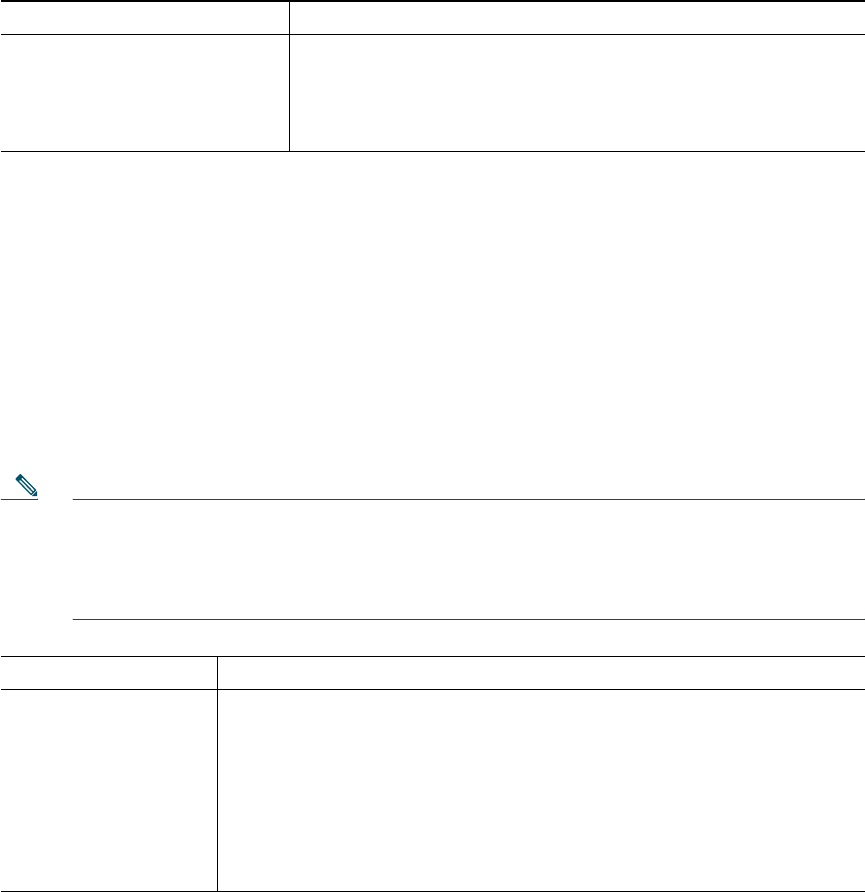
66 OL-10806-01
FINAL REVIEW - Cisco Confidential
Tips
•Use your PIN to log in to Cisco Extension Mobility or Personal Directory on your phone.
•Use your password to log in to your User Options web pages and Cisco WebDialer on your
personal computer.
•For more information about these services, ask your phone administrator.
Controlling Line Settings on the Web
Line settings affect a specific phone line (directory number) on your phone. Line settings can include
call-forwarding and line labels.
Note • You can set up call forwarding (for your primary phone line) directly on your phone. See
Forwarding All Calls to Another Number, page 31.
•To learn about phone settings that you can access directly on your phone, see Using Phone
Settings, page 45.
Change the language (locale) for
your phone screen
1. Go to the Device Configuration page by choosing User
Options > Device.
2. Choose an item from the User Locale drop-down list.
3. Click Save.
If you want to... Then do this after you log in...
Set up call forwarding
per line
1. Select the Cisco Unified Wireless IP Phone 7921G device.
2. Click Line Settings.
3. If you have more than one directory number (line) assigned to your
phone, verify that the appropriate line is selected or choose a new one.
4. In the Incoming Call Forwarding area, choose call forwarding settings
for various conditions.
5. Click Save.
If you want to... Then do this after you log in...

Accessing Your User Options Web Pages
Cisco Unified Wireless IP Phone 7921G for Cisco Unified CallManager 4.1, 4.2, 5.0 and Later 67
FINAL REVIEW - Cisco Confidential
Tip
You cannot change the Ring Settings for the Cisco Unified Wireless IP Phone 7921G from the User
Options web pages.
Change the voice
message indicator
setting per line
1. Select your device.
2. Click Line Settings.
3. If you have more than one directory number (line) assigned to your
phone, verify that the appropriate line is selected or choose a new one.
4. In the Message Waiting Lamp area, choose from various settings.
Note Typically, the default message waiting setting prompts your phone to
display a light and a message to indicate a new voice message.
5. Click Save.
Change or create a line
text label that appears
on your phone screen
1. Select your device.
2. Click Line Settings.
3. If you have more than one directory number (line) assigned to your
phone, verify that the appropriate line is selected or choose a new one.
4. In the Line Text Label area, enter a text label.
5. Click Save.
If you want to... Then do this after you log in...

68 OL-10806-01
FINAL REVIEW - Cisco Confidential
Using Cisco WebDialer
Cisco WebDialer allows you to make calls on your wireless IP phone to directory contacts by clicking
items in a web browser. Your phone administrator must configure this feature for you.
If you want to... Then...
Use WebDialer with
your User Options
directory
1. Log into your User Options web pages. See Accessing Your User Options
Web Pages, page 59.
2. Choose User Options > Directory and search for a coworker.
3. Click the number that you want to dial.
4. If this is your first time using WebDialer, set up preferences and click
Submit. (See the last row in this table for details.)
5. If the Make Call page appears, click Dial. (See the last row in this table
to learn how to suppress this page in the future, if desired.)
The call is now placed on your phone.
6. To end a call, click Hangup or disconnect from your phone.
Use WebDialer with
another online
corporate directory
(not your User
Options directory)
1. Log into a WebDialer-enabled corporate directory and search for
coworkers.
2. Click the number that you want to dial.
3. When prompted, enter your user ID and password.
4. If this is your first time using WebDialer, set up preferences and click
Submit. (See the last row in this table for details.)
5. If the Make Call page appears, click Dial. (See the last row in this table
to learn how to suppress this page in the future, if desired.)
The call is now placed on your phone.
6. To end a call, click Hangup or disconnect from your phone.

Accessing Your User Options Web Pages
Cisco Unified Wireless IP Phone 7921G for Cisco Unified CallManager 4.1, 4.2, 5.0 and Later 69
FINAL REVIEW - Cisco Confidential
Log out of WebDialer Click the logout icon in the Make Call or Hang Up page.
Set up, view, or
change WebDialer
preferences
Access the Preferences page.
The Preferences page appears the first time that you use WebDialer (after you
click the number that you want to dial).
To return to Preferences in the future, click the preferences icon from the
Make Call or Hang Up page.
The Preferences page contains the following options:
•Preferred language—Determines the language used for WebDialer
settings and prompts.
•Use permanent device—Identifies the wireless IP phone and directory
number (line) that you will use to place WebDialer calls. If you have one
phone with a single line, the appropriate phone and line are
automatically selected. Otherwise, choose a phone and/or line. Phones
are specified by host name. (To display the host name on your phone,
choose (Settings) >Network Profile > Network Configuration >
Host Name.)
•Use Extension Mobility—If selected, prompts WebDialer to use the
wireless IP phone that is associated with your Extension Mobility profile
(if available).
•Do not display call confirmation—If selected, prompts WebDialer to
suppress the Make Call page. This page appears by default after you click
a phone number in a WebDialer-enabled online directory.
If you want to... Then...

70 OL-10806-01
FINAL REVIEW - Cisco Confidential
Understanding Additional Configuration Options
Your system administrator can configure your phone to use specific softkey templates along with
special services and features, if appropriate. The table below provides an overview of some
configuration options that you might want to discuss with your phone system administrator based on
your calling needs or work environment.
Note You can locate User Guides and other documents listed in this table from the following URL:
http://www.cisco.com/univercd/cc/td/doc/product/voice/c_ipphon/index.htm
If you... Then... For more information...
Need to handle
more calls on your
phone line
Ask your system administrator to
configure your line to support more calls.
Talk to your system administrator
or phone support team.
Need more than
one phone line
Ask your system administrator to
configure one or more additional directory
numbers for you.
Talk to your system administrator
or phone support team.
Need different
softkeys, such as
iDivert to display
when phone is
ringing or in use.
Ask your system administrator to
configure a new softkey template and
assign it to your phone.
Talk to your system administrator
or phone support team.
Need more speed
dial numbers
First make sure that you are using all of
your currently available speed dial
numbers.
If you need additional speed dial numbers,
try using Abbreviated Dialing or
subscribing to the Fast Dial service.
See Subscribing to Phone Services,
page 58.
Want to use one
directory number
for several phones
Request a shared line. This allows you to
use one number for your desk phone and
your wireless IP phone, for example.
See Using a Shared Line, page 37.

Understanding Additional Configuration Options
Cisco Unified Wireless IP Phone 7921G for Cisco Unified CallManager 4.1, 4.2, 5.0 and Later 71
FINAL REVIEW - Cisco Confidential
Share phones or
office space with
co-workers
Consider using:
•Call Park to store and retrieve calls
without using the transfer feature.
•Call Pickup to answer calls ringing on
another phone.
•A shared line to view or join
co-workers’ calls.
•Cisco Extension Mobility to apply
your phone number and user profile to
a shared phone
Ask your system administrator
about these features and see the:
•Storing and Retrieving Parked
Calls, page 39
•Using a Shared Line, page 37
•“Using the Extension
Mobility Service” in
Customizing Your Cisco
Unified IP Phone on the Web
Answer calls
frequently or
handle calls on
someone’s behalf
Ask your system administrator to set up
the AutoAnswer feature for your phone.
See Using AutoAnswer, page 44.
Want to
temporarily apply
your phone
number and
settings to a shared
Cisco Unified IP
Phone
Ask your system administrator about the
Cisco Extension Mobility service.
See “Using the Extension Mobility
Service” in Customizing Your
Cisco Unified IP Phone on the
Web.
Allow or prevent
all phones with the
same shared line to
view call
information or join
a call on the shared
line
Ask your system administrator to set up
the Privacy feature for those phones.
See Preventing Others from
Viewing or Joining a Shared-Line
Call, page 39.
If you... Then... For more information...

72 OL-10806-01
FINAL REVIEW - Cisco Confidential
Troubleshooting Your Phone
This section provides troubleshooting information for your Cisco Unified Wireless IP Phone 7921G.
General Troubleshooting
This section provides information to help you troubleshoot general problems with your phone. For
more information, see your phone administrator.
Symptom Explanation
You cannot complete a
call
One or more of the following factors might apply:
•Your phone is out of the wireless network access point service area.
Note Your phone shows a green blinking indicator light when it is within the
service coverage area.
•You must log into the Extension Mobility service.
•You must enter a client matter code or forced authorization code after
dialing a number.
•Your phone has time-of-day restrictions that prevent you from using
some features during certain hours of the day.
The main phone screen
is not active
One of these messages appears on the status line:
•Network busy—Not enough bandwidth available in wireless network
to complete this call. Try again later.
•Leaving service area—Phone is out of range of its associated access
point and wireless network.
•Locating network services—Phone is searching for a wireless network
access point.
•Authentication failed—Security credentials are not accepted by the
authentication server.
•Configuring IP—Phone is waiting for DHCP to assign an IP address.
The Settings menu is
unresponsive
Your phone administrator might have disabled Settings on your phone.
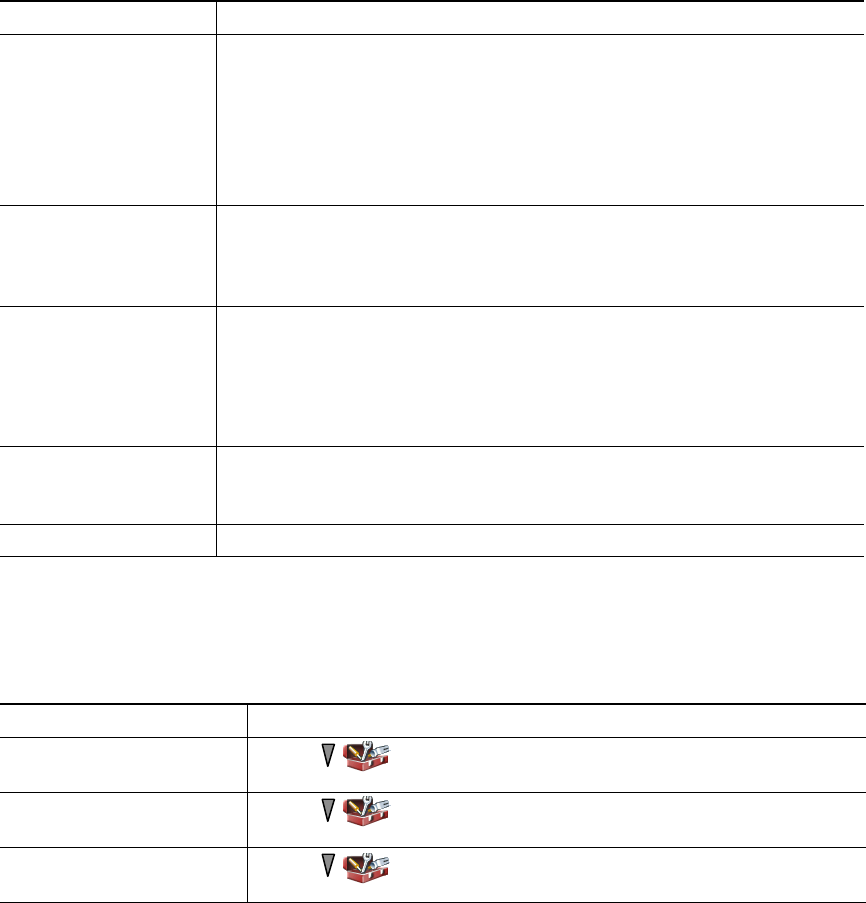
Troubleshooting Your Phone
Cisco Unified Wireless IP Phone 7921G for Cisco Unified CallManager 4.1, 4.2, 5.0 and Later 73
FINAL REVIEW - Cisco Confidential
Viewing Phone Administration Data
Your phone administrator might ask you to access administration data on your phone for
troubleshooting purposes.
The softkey that you
want to use does not
appear
One or more of the following factors might apply:
•You must press Options and scroll to reveal additional softkeys.
•You must change the line state (for example, place a call or have a
connected call).
•Your phone is not configured to support the feature associated with
that softkey.
Join fails Join requires multiple selected calls. Be sure that you have selected at least
one call in addition to the active call, which is selected automatically. Join
also requires the selected calls to be on the same line. If necessary, transfer
calls to one line before joining them.
Barge fails and results
in a fast busy tone
One or more of the following factors might apply:
•You cannot barge an encrypted call if the phone you are using is not
configured for encryption. When your barge attempt fails for this
reason, your phone plays a fast busy tone.
•You cannot barge a call on another Cisco Unified Wireless IP Phone.
You are disconnected
from a call that you
joined using Barge
You will be disconnected from a call that you have joined using Barge if the
call is put on hold, transferred, or turned into a conference call.
Cisco CallBack fails The other party might have call forwarding enabled.
If you are asked to... Then...
Access network
configuration data
Choose (Settings) > Device Information > Network and select
the network configuration item that you want to view.
Access status data Choose (Settings) > Status and select the status item that you
want to view.
Access phone call and voice
quality information
Choose (Settings) > Status > Call Statistics.
Symptom Explanation
74 OL-10806-01
FINAL REVIEW - Cisco Confidential
Using the Quality Reporting Tool
Your phone administrator may temporarily configure your phone with the Quality Reporting Tool
(QRT) to troubleshoot performance problems. You can choose Options > QRT to submit information
to your phone administrator. Depending on configuration, use the QRT to:
•Immediately report an audio problem on the current call
•Select a general problem from a list of categories and choose reason codes

74 OL-10806-01
FINAL REVIEW - Cisco Confidential
Cisco One-Year Limited Hardware Warranty Terms
There are special terms applicable to your hardware warranty and various services that you can use
during the warranty period. Your formal Warranty Statement, including the warranty applicable to
Cisco software, is included on the Cisco Documentation CD and on Cisco.com. Follow these steps to
access and download the Cisco Information Packet and your warranty document from the CD or
Cisco.com.
1. Launch your browser, and go to this URL:
http://www.cisco.com/univercd/cc/td/doc/es_inpck/cetrans.htm
The Warranties and License Agreements page appears.
2. To r ead the Cisco Information Packet, follow these steps:
a. Click the Information Packet Number field, and make sure that the part number
78-5235-03B0 is highlighted.
b. Select the language in which you would like to read the document.
c. Click Go.
d. The Cisco Limited Warranty and Software License page from the Information Packet appears.
e. Read the document online, or click the PDF icon to download and print the document in
Adobe Portable Document Format (PDF).
Note You must have Adobe Acrobat Reader to view and print PDF files. You can download
the reader from Adobe’s website: http://www.adobe.com
3. To read translated and localized warranty information about your product, follow these steps:
a. Enter this part number in the Warranty Document Number field:
78-10747-01C0
b. Select the language in which you would like to view the document.
c. Click Go.
The Cisco warranty page appears.
d. Read the document online, or click the PDF icon to download and print the document in
Adobe Portable Document Format (PDF).
You can also contact the Cisco service and support website for assistance:
http://www.cisco.com/public/Support_root.shtml.

Cisco One-Year Limited Hardware Warranty Terms
Cisco Unified Wireless IP Phone 7921G for Cisco Unified CallManager 4.1, 4.2, 5.0 and Later 75
FINAL REVIEW - Cisco Confidential
Duration of Hardware Warranty
One (1) Year
Replacement, Repair, or Refund Policy for Hardware
Cisco or its service center will use commercially reasonable efforts to ship a replacement part within
ten (10) working days after receipt of a Return Materials Authorization (RMA) request. Actual
delivery times can vary, depending on the customer location.
Cisco reserves the right to refund the purchase price as its exclusive warranty remedy.
To Receive a Return Materials Authorization (RMA) Number
Contact the company from whom you purchased the product. If you purchased the product directly
from Cisco, contact your Cisco Sales and Service Representative.
Complete the information below, and keep it for reference.
Company product purchased from
Company telephone number
Product model number
Product serial number
Maintenance contract number

Cisco Unified Wireless IP Phone 7921G for Cisco Unified CallManager 4.1, 4.2, 5.0 and Later 1
FINAL REVIEW - Cisco Confidential
Index
A
update latest index entries..l.ll
Abbreviated Dialing 60
accessibility 5
accessories for phone 12
Address Book Synchronization Tool 64
answering calls 27
authenticated calls 40
auto keylock 49
AutoAnswer, using 44
B
barge
and privacy 39
and shared lines 37
using 38
battery
installing 6
removing 6
safety notices 3
billing codes, dialing with 26
C
call forwarding 31
configuring from web page 66
call history
menu options 51
viewing and dialing from 51
call logs
erasing 51
viewing and dialing from 51
call park 39
call waiting 27
CallBack 26
call-handling, advanced 35
call-handling, basic 24
calls
answering 27
compared to lines 21
conference features for 32
ending 28
forwarding 31, 66
handling multiple 29
holding and resuming 28
icons for 22
multiple parties on 32
muting 29
parking 39
placing 24, 25
prioritizing 41
redirecting while ringing 27
secure 40
Cisco Unified Wireless IP Phone 7921G for Cisco Unified CallManager 4.1, 4.2, 5.0 and Later 2
FINAL REVIEW - Cisco Confidential
selecting 22
storing and retrieving 39
transferring 30
cBarge
See also barge
using 38
Cisco Unified IP Phone
online help for 20
Cisco Unified Wireless IP Phone
accessories 12
buttons and keys 14
cleaning 23
connecting 6
description of 14
feature configuration for 23, 70
power supply 5
powering on 10
registering 12
regulatory domains 2
safety and performance 2
troubleshooting 72
web-based services for 57
Cisco WebDialer 68
conference calls
Meet-Me 32, 34
standard 32
corporate directory
using 52
using from web page 68
D
device configuration page 57, 59
dialing, options for 24, 25
directory
corporate, using 52
option descriptions 51
personal, using 52
using from web page 68
E
encrypted calls 40
ending a call, options for 28
Extension Mobility
log in 42
log out 42
using 26, 42
extension numbers, viewing 17
F
Fast Dial service
dialing with 26
subscribing to 58
Fast Dials
configuring from web page 63
feature buttons
display of 19
feature menus 19
features
accessibility 5
adding additional 70
availability of 23
forwarding calls, options for 31
3OL-10806-01
FINAL REVIEW - Cisco Confidential
H
handset
using 43
hanging up, options for 28
headset
choosing ringer volume 45, 46
mode, using 43
ordering 13
quality 12
using 12
using external devices 5
help, using 20
hold
and switching calls 29
and transferring 30
using 28
hunt group
description of 42
log out 42
I
icons, for call states 22
installing, Cisco Unified Wireless IP Phone 6
K
keylock 21
keypad lock
auto keylock feature 49
lock keypad 21
setting auto keylock 49
unlocking keypad 21, 49
keypad shortcuts 21
L
language (locale) settings 65
lines
and call forwarding 66
description of 21
ring patterns for 66
text label for 66
viewing 17
voice message indicator setting for 66
log out of hunt groups 42
M
Malicious Call Identification (MCID) 40
Meet-Me conferences 32, 34
menus, using 19
missed calls, records of 51
MLPP, using 41
multiple calls, handling 29
mute, using 29
N
network configuration data, locating 73
network profile
choosing 50
viewing 50
Cisco Unified Wireless IP Phone 7921G for Cisco Unified CallManager 4.1, 4.2, 5.0 and Later 4
FINAL REVIEW - Cisco Confidential
O
online help, using 20
P
PAB
using from web page 62
password
changing EAP 50
network EAP 11
setting 11
password, changing 65
Personal Address Book (PAB)
dialing from 26
subscribing to 58
Personal Address Book, see PAB
Personal Directory
using from web page 61
phone buttons
description 14
phone buttons, using 21
phone lines
description of 21
viewing 17
phone profile
network profile 50
network profile, choosing 50
phone screen
change back light 47
change font 47
changing messages 47
cleaning 23
features of 17
phone services
configuring
see also User Options web pages
PIN, changing 65
placed calls, records of 51
placing calls, options for 24, 25
power outage 5
power supply 5
powering on 10
prioritizing calls 41
privacy
and shared lines 37
using 39
Q
Quality Reporting Tool (QRT), using 73
R
received calls, records of 51
redial 24
regulatory domains 2
remote-in-use for shared lines 37
resume, using 28
ring patterns, changing 66
ring tones
change 45, 46
choosing per line 45, 46
download 45, 46
ringer
volume 45, 46
5OL-10806-01
FINAL REVIEW - Cisco Confidential
S
safety and performance 2
secure calls 40
security
levels of 40
making and receiving secure calls 40
verifying non-secure calls 40
selecting calls 22
services, subscribing to 58, 64
shared lines
and in-use-remote message 37
description of 37
with barge 38
with privacy 39
softkey buttons
labels for 17
speakerphone
mode, using 43
speed dial
configuring 60
labels 60
options 35
using FastDial 35
using numbers 35
status data, locating 73
status line, viewing 17
subscriptions, for phone services 64
suspicious calls, tracing 40
switching calls 29
T
TABSynch 64
TAPS, using 12
Tool for Auto-Registered Phones Support 12
transferring, options for 30
troubleshooting, data for 72
U
User Options web pages
accessing 57
and phone services 58
configuring features and services with 60
subscribing to phone services with 64
V
vibration mode
icon 21
set 21
voice message indicator
changing setting for 66
voice messages
accessing 56
indicator 56
shortcut 21
voice quality data, locating 73
volume
adjusting 45, 46
volume, changing speaker 21
7OL-10806-01
FINAL REVIEW - Cisco Confidential

Corporate Headquarters
Cisco Systems, Inc.
170 West Tasman Drive
San Jose, CA 95134-1706
USA
www.cisco.com
Tel: 408 526-4000
800 553-NETS (6387)
Fax: 408 526-4100
European Headquarters
Cisco Systems International BV
Haarlerbergpark
Haarlerbergweg 13-19
1101 CH Amsterdam
The Netherlands
www-europe.cisco.com
Tel: 31 0 20 357 1000
Fax: 31 0 20 357 1100
Americas Headquarters
Cisco Systems, Inc.
170 West Tasman Drive
San Jose, CA 95134-1706
USA
www.cisco.com
Tel: 408 526-7660
Fax: 408 527-0883
Asia Pacific Headquarters
Cisco Systems, Inc.
168 Robinson Road
#28-01 Capital Tower
Singapore 068912
www.cisco.com
Tel: +65 6317 7777
Fax: +65 6317 7799
Cisco Systems has more than 200 offices in the following countries. Addresses, phone numbers, and fax numbers are listed on the
Cisco Website at www.cisco.com/go/offices
Argentina • Australia • Austria • Belgium • Brazil • Bulgaria • Canada • Chile • China PRC • Colombia • Costa Rica • Croatia • Cyprus • Czech Republic • Denmark • Dubai, UAE
Finland • France • Germany • Greece • Hong Kong SAR • Hungary • India • Indonesia • Ireland • Israel • Italy • Japan • Korea • Luxembourg • Malaysia • Mexico
The Netherlands • New Zealand • Norway • Peru • Philippines • Poland • Portugal • Puerto Rico • Romania • Russia • Saudi Arabia • Scotland • Singapore
Slovakia • Slovenia • South Africa • Spain • Sweden • Switzerland • Taiwan • Thailand • Turkey • Ukraine • United Kingdom • United States • Venezuela • Vietnam • Zimbabwe
CCSP, CCVP, the Cisco Square Bridge logo, Follow Me Browsing, and StackWise are trademarks of Cisco Systems, Inc.; Changing the Way We Work, Live, Play, and Learn, and
iQuick Study are service marks of Cisco Systems, Inc.; and Access Registrar, Aironet, BPX, Catalyst, CCDA, CCDP, CCIE, CCIP, CCNA, CCNP, Cisco, the Cisco Certified
Internetwork Expert logo, Cisco IOS, Cisco Press, Cisco Systems, Cisco Systems Capital, the Cisco Systems logo, Cisco Unity, Enterprise/Solver, EtherChannel, EtherFast,
EtherSwitch, Fast Step, FormShare, GigaDrive, GigaStack, HomeLink, Internet Quotient, IOS, IP/TV, iQ Expertise, the iQ logo, iQ Net Readiness Scorecard, LightStream,
Linksys, MeetingPlace, MGX, the Networkers logo, Networking Academy, Network Registrar, Packet, PIX, Post-Routing, Pre-Routing, ProConnect, RateMUX, ScriptShare,
SlideCast, SMARTnet, The Fastest Way to Increase Your Internet Quotient, and TransPath are registered trademarks of Cisco Systems, Inc. and/or its affiliates in the United
States and certain other countries.
All other trademarks mentioned in this document or Website are the property of their respective owners. The use of the word partner does not imply a partnership relationship
between Cisco and any other company. (0601R)
© 2006 Cisco Systems, Inc. All rights reserved.
OL-10806-01